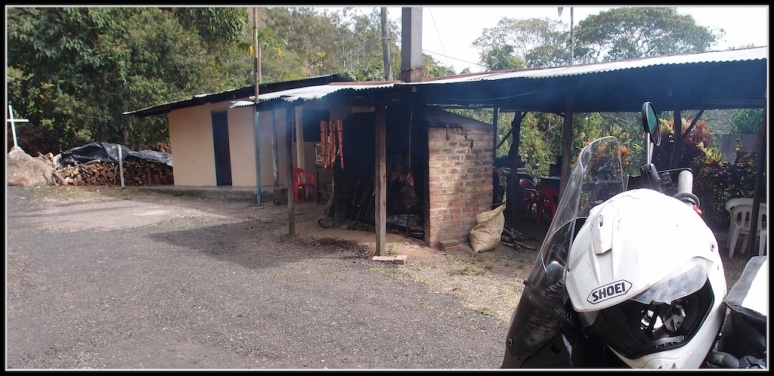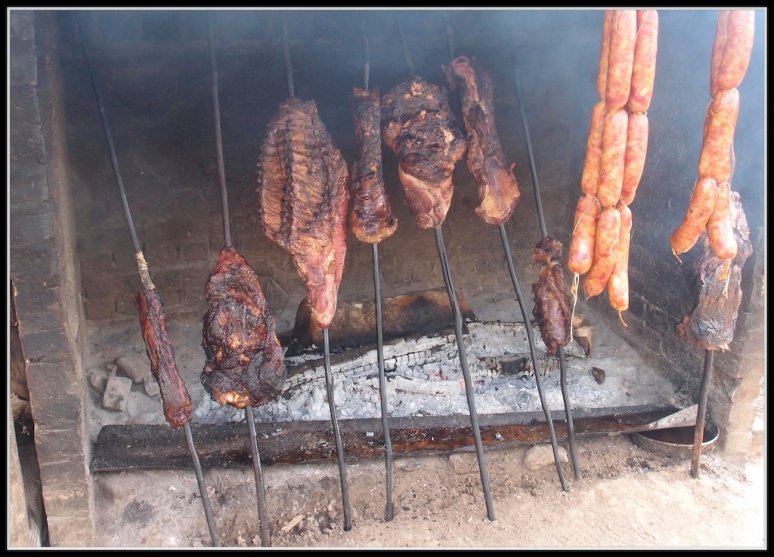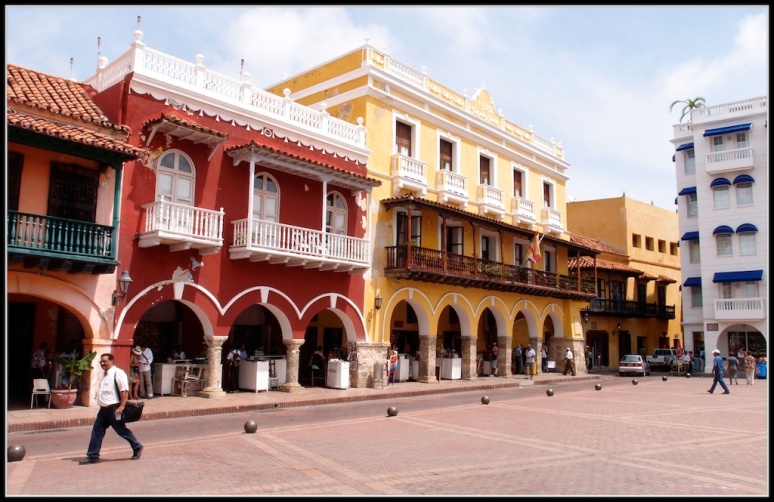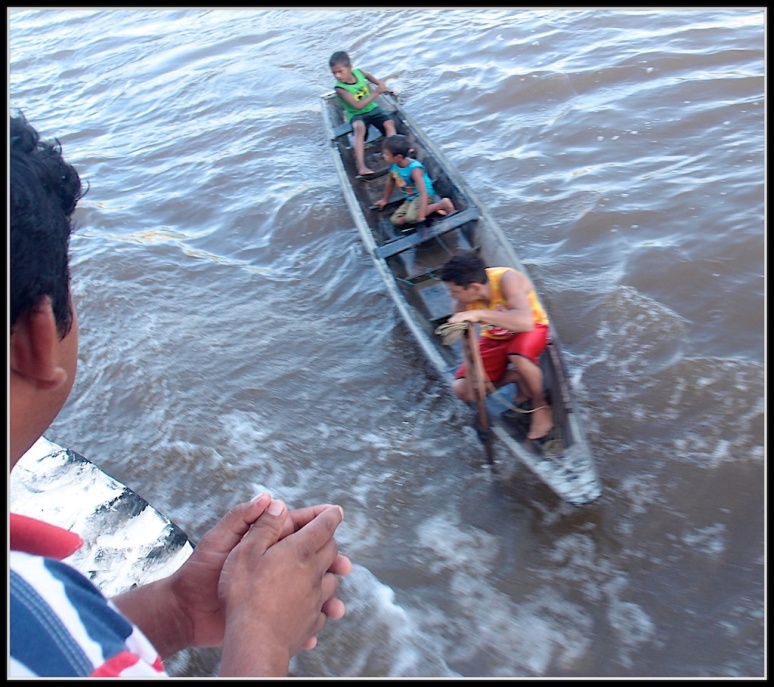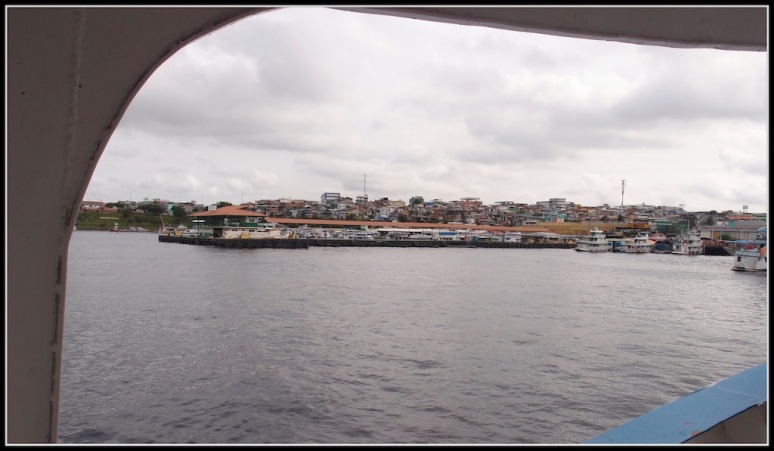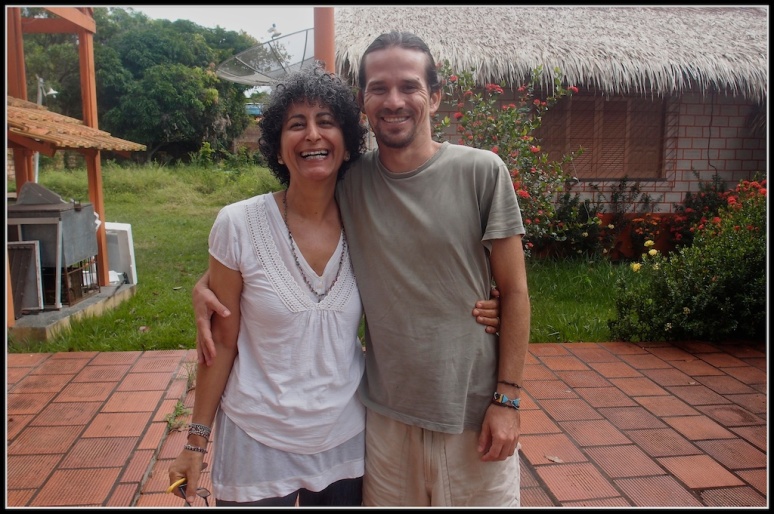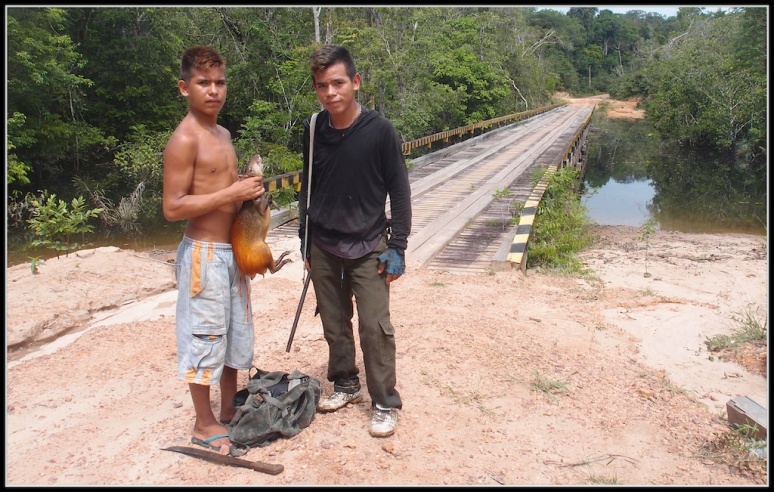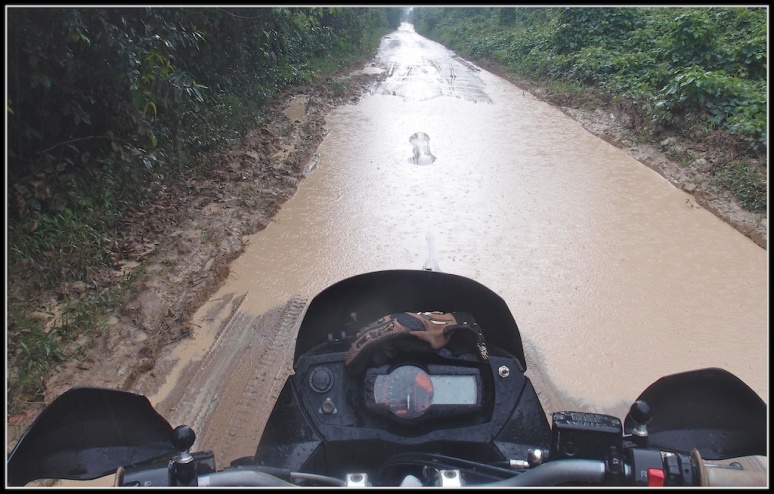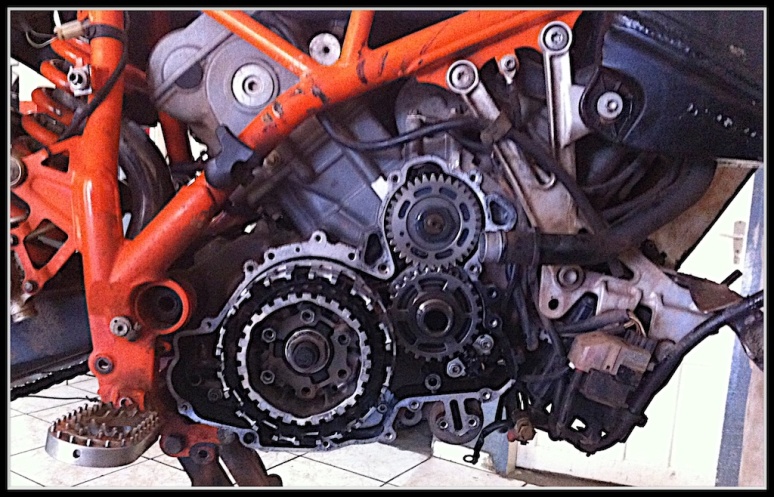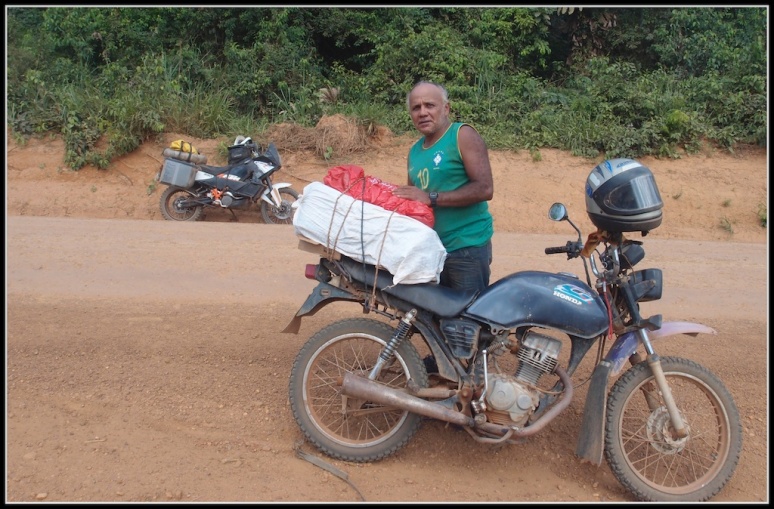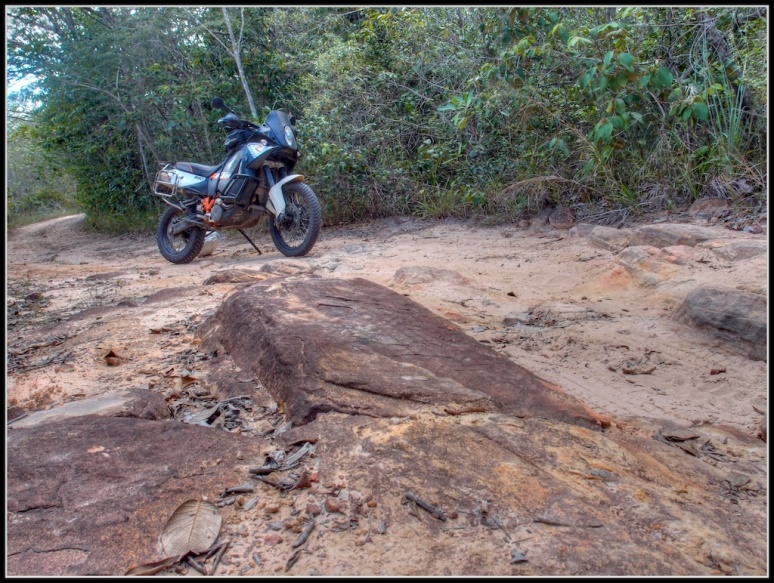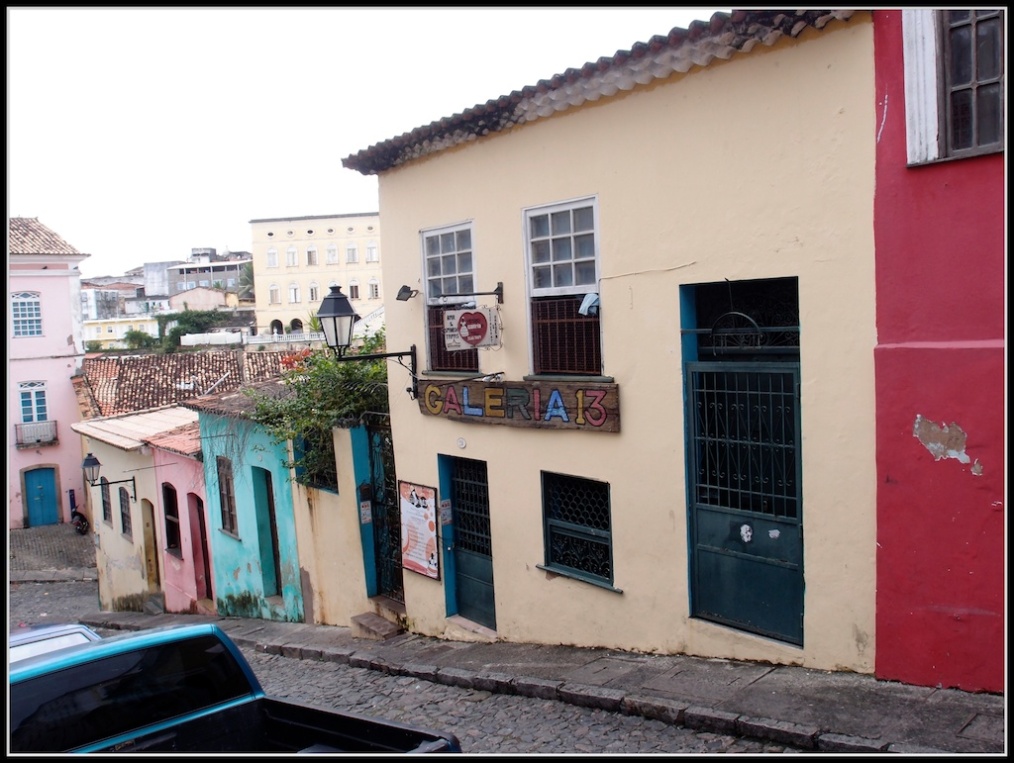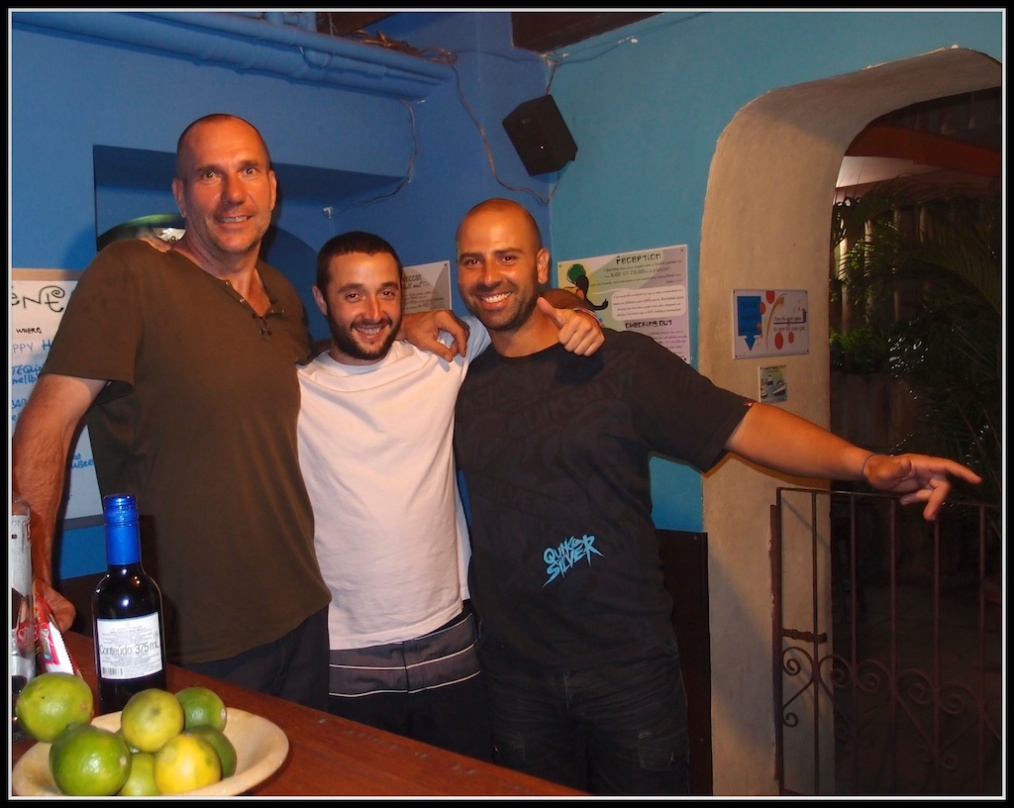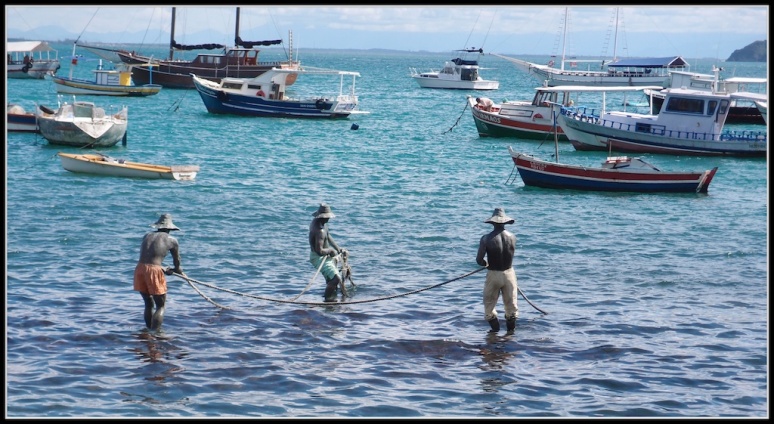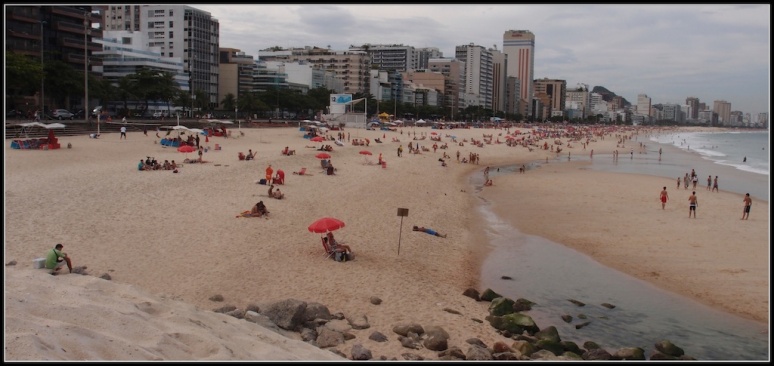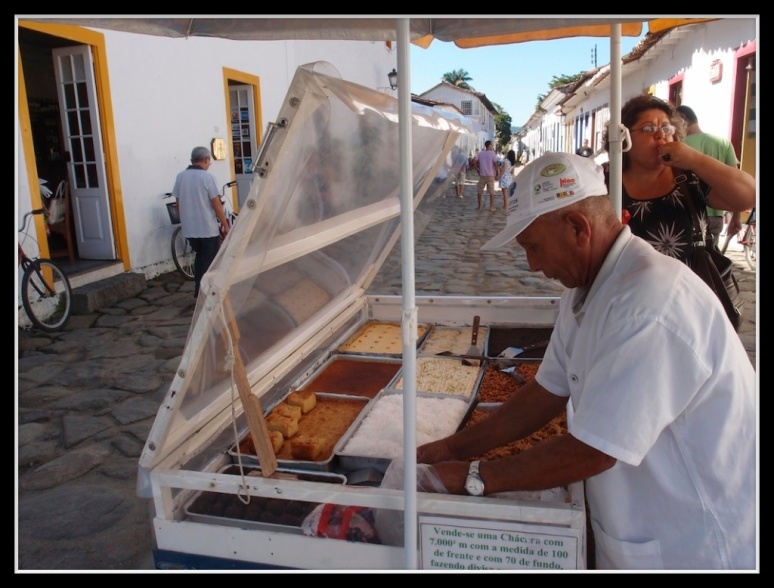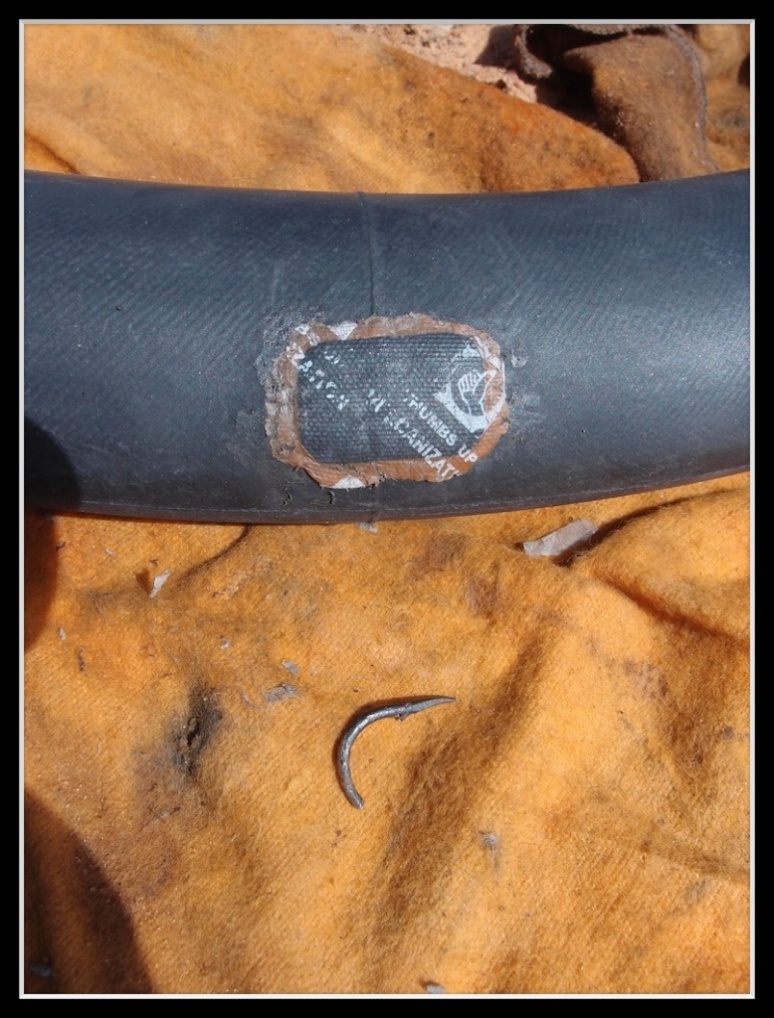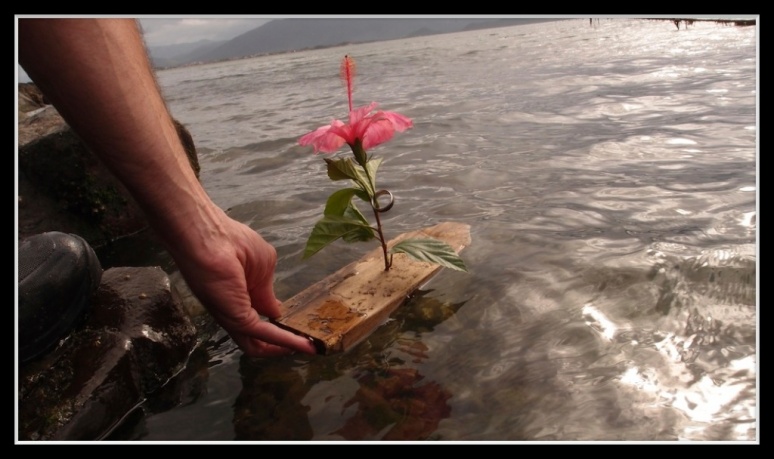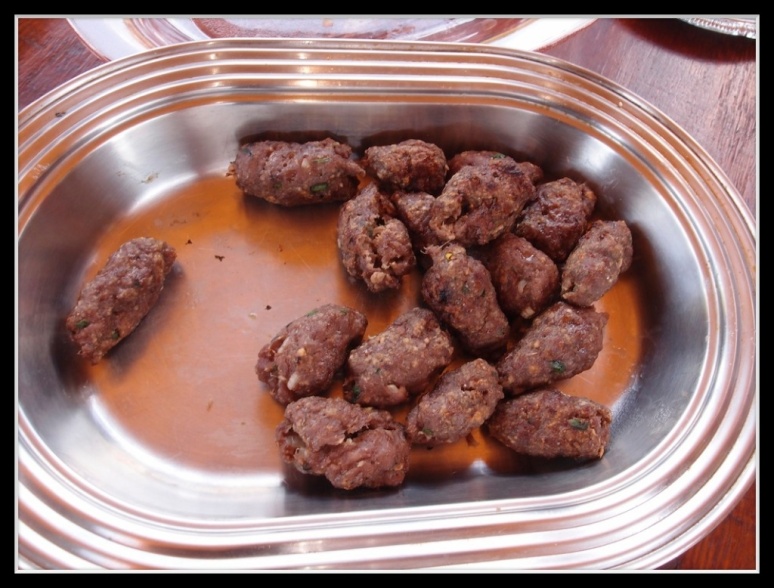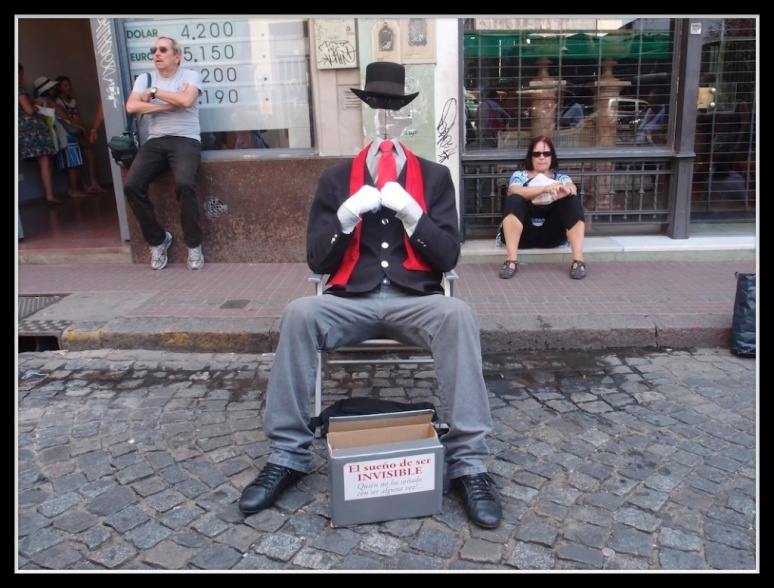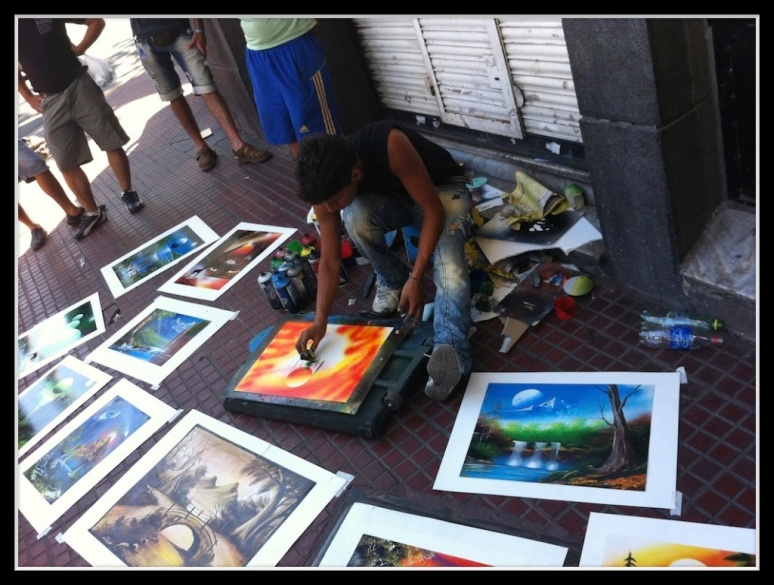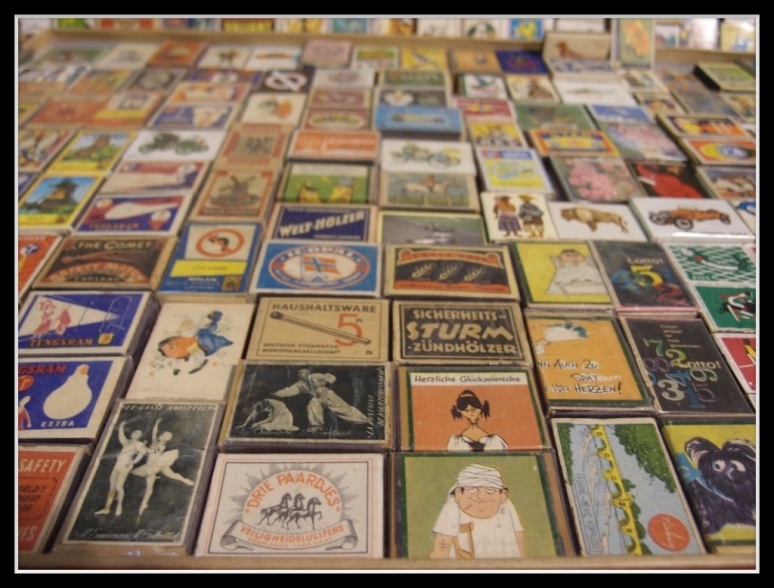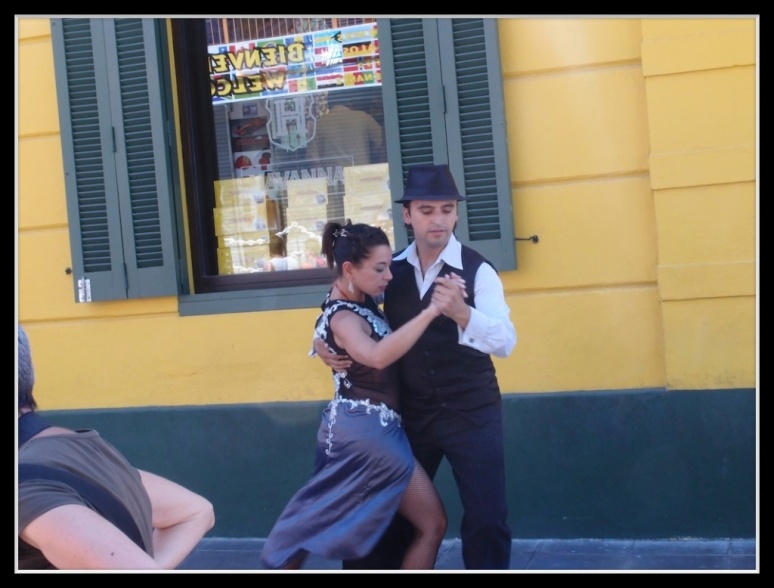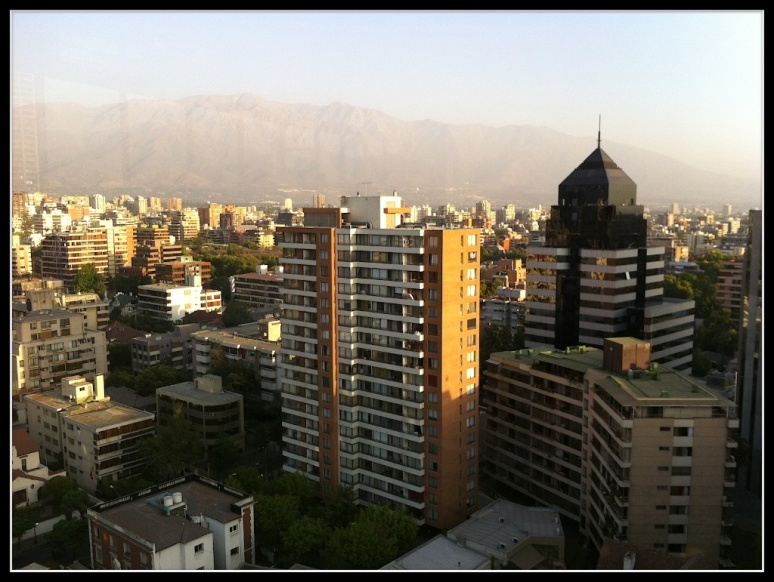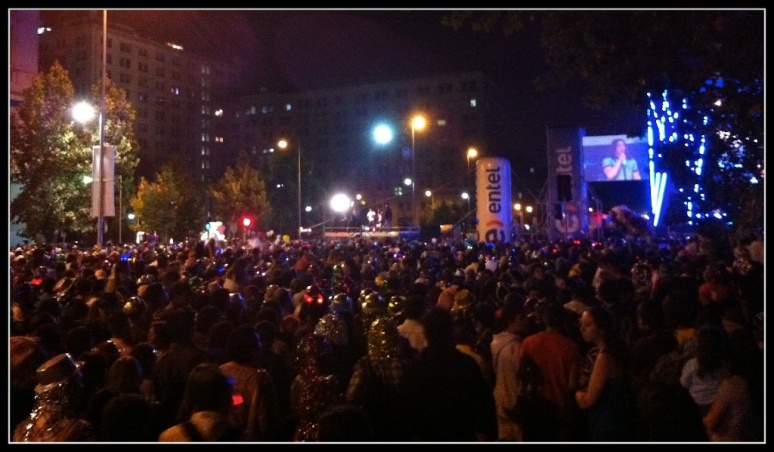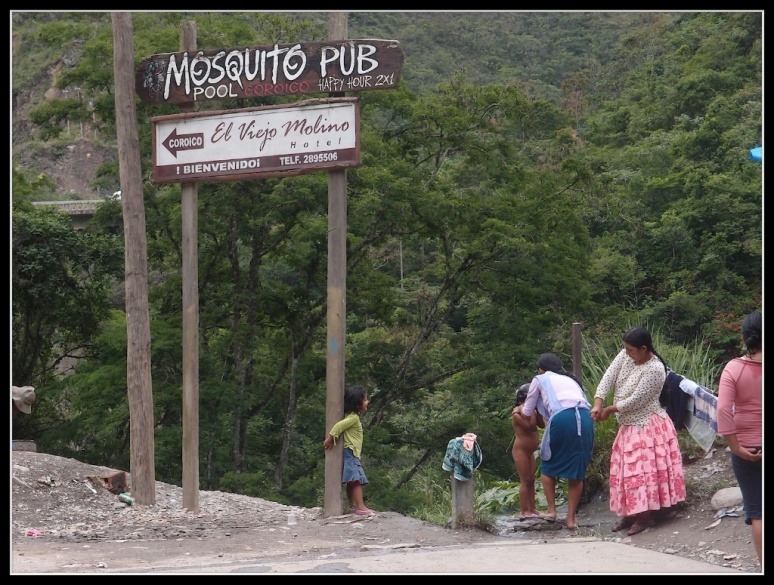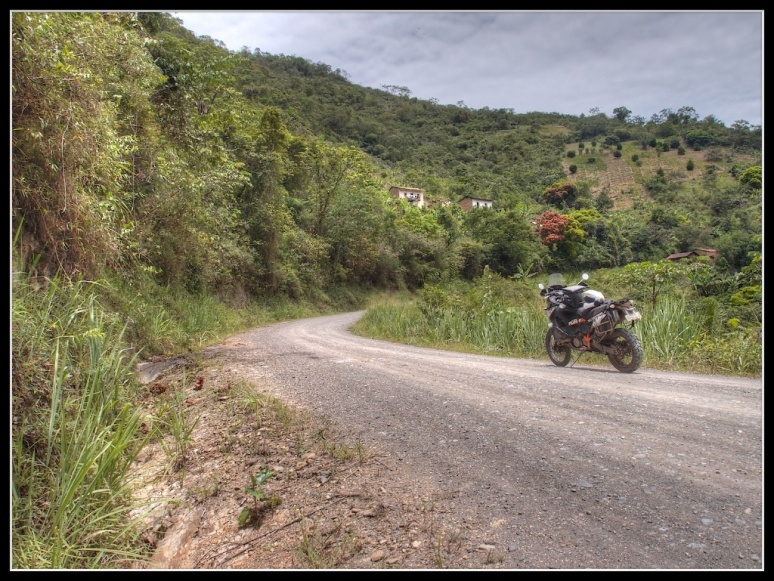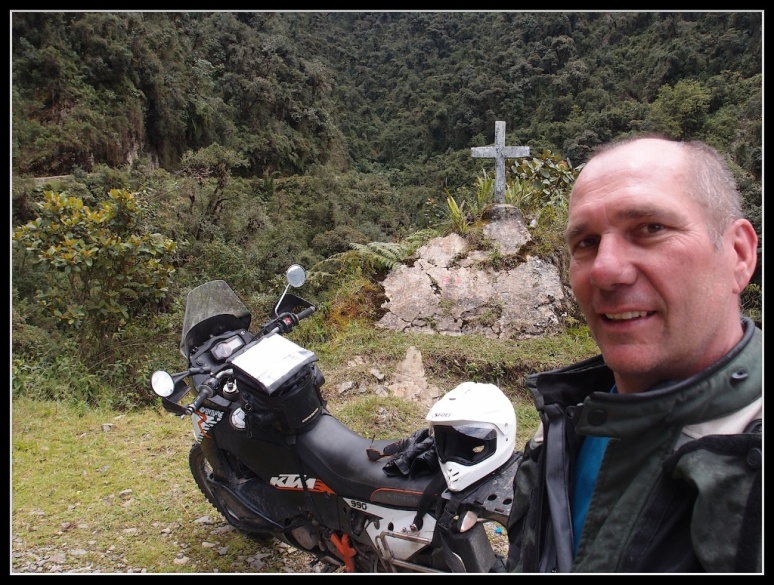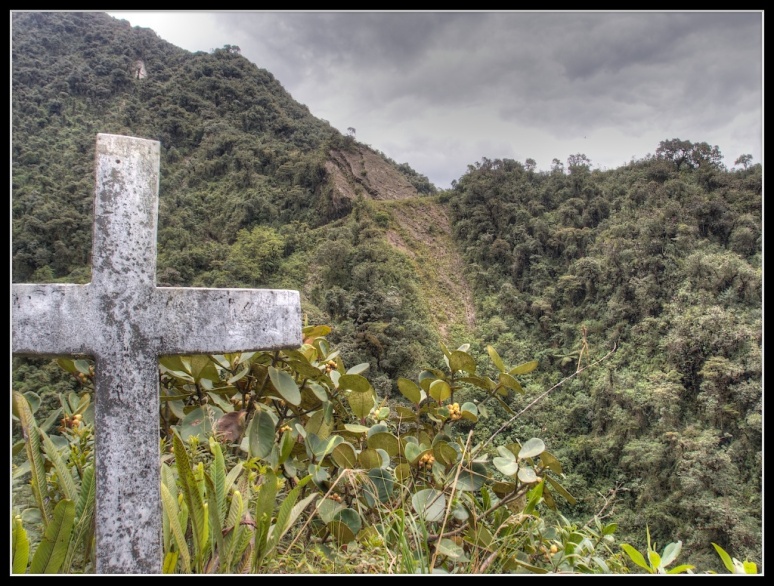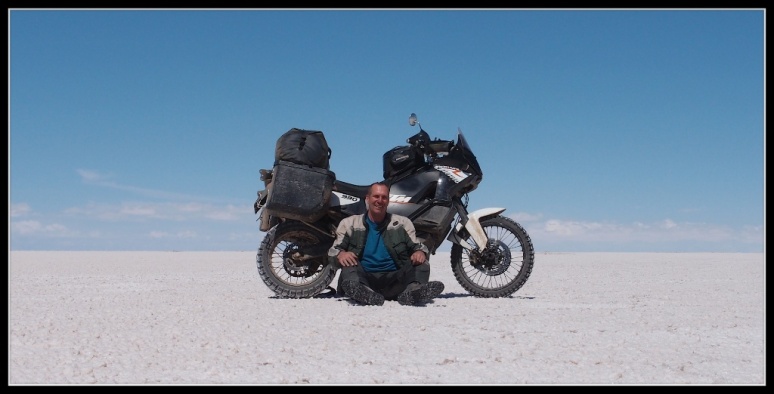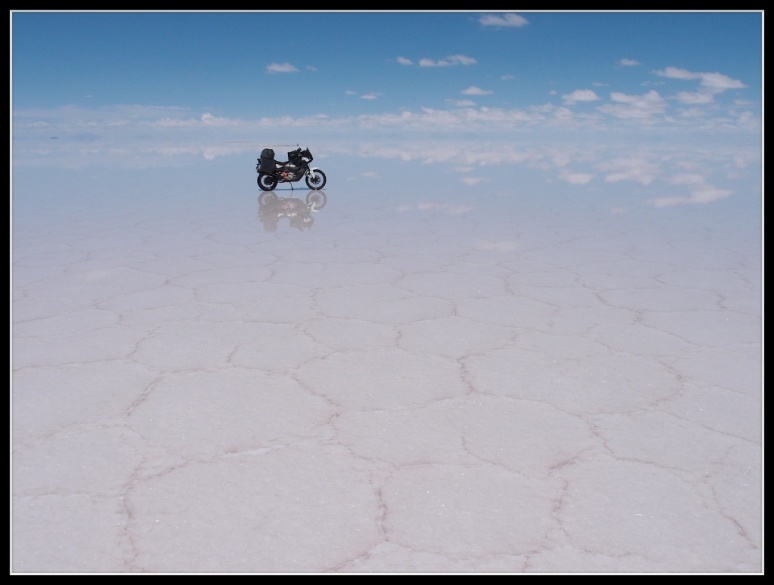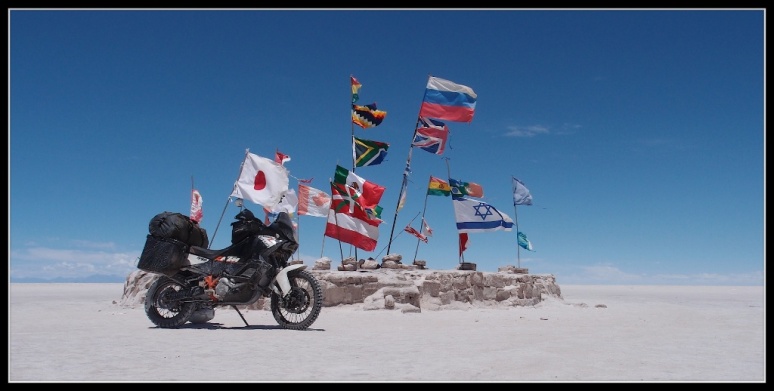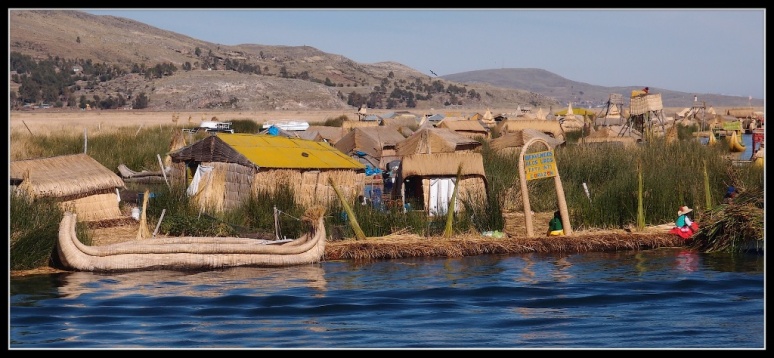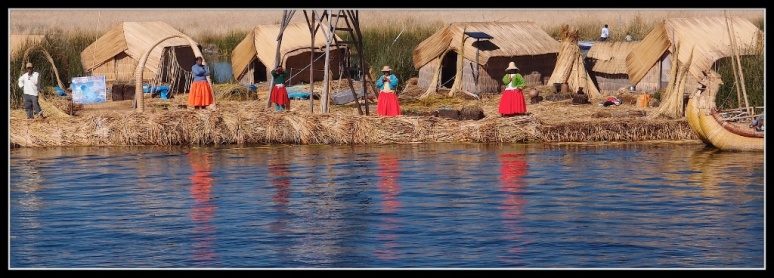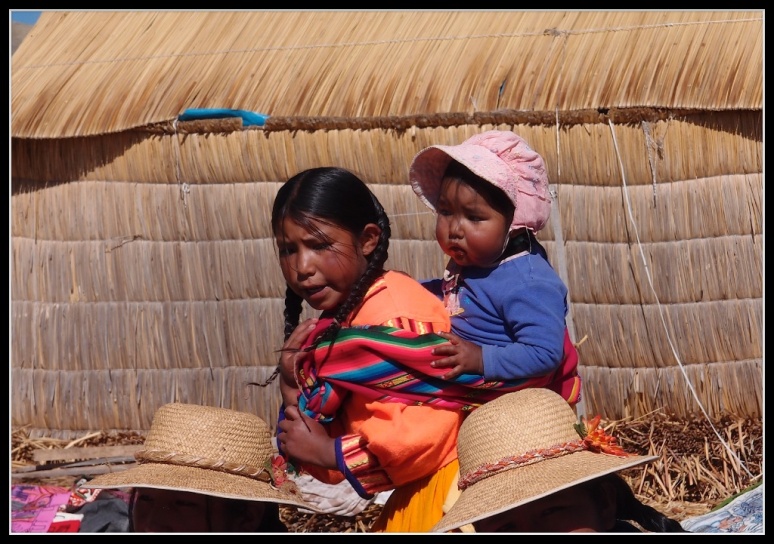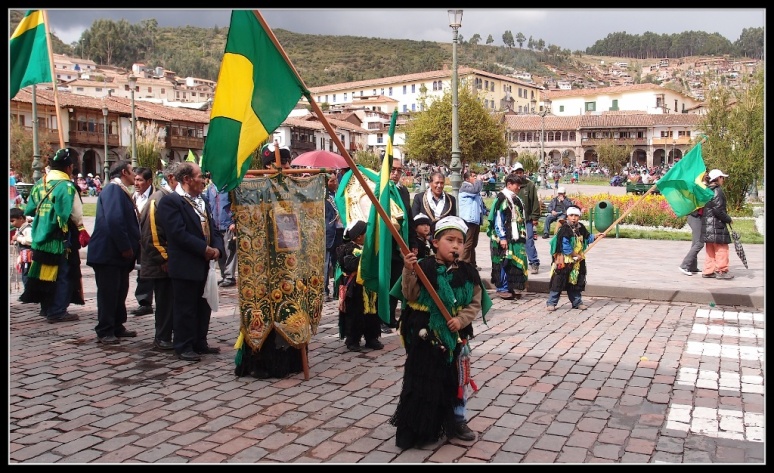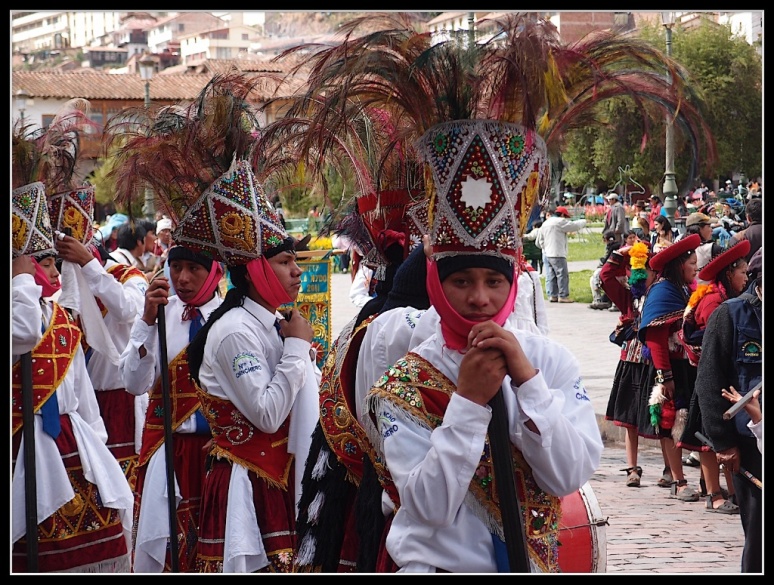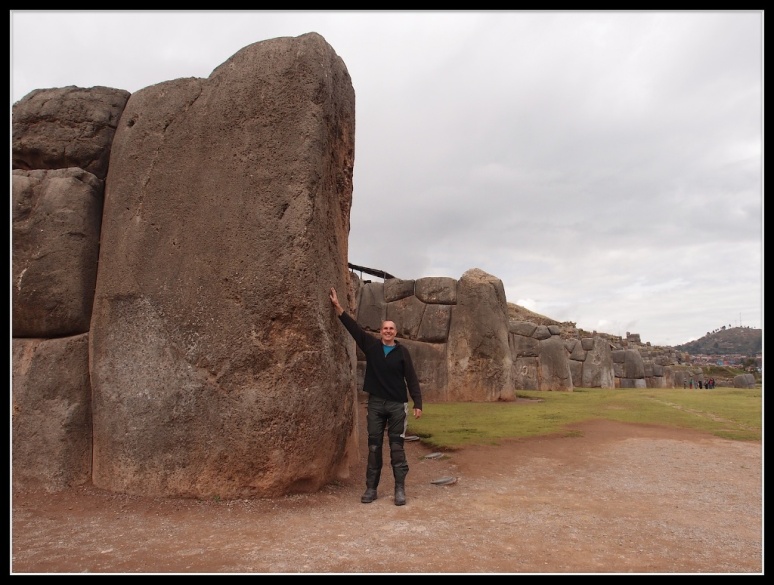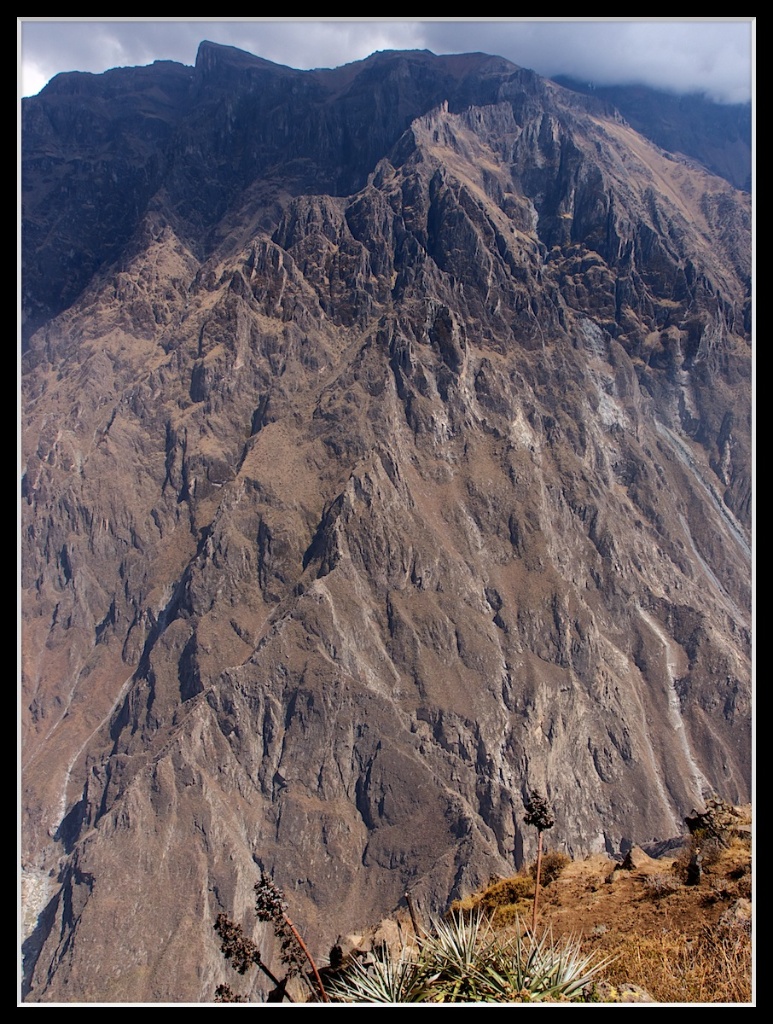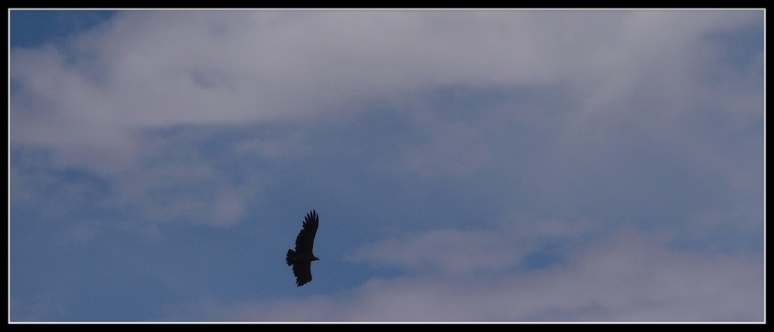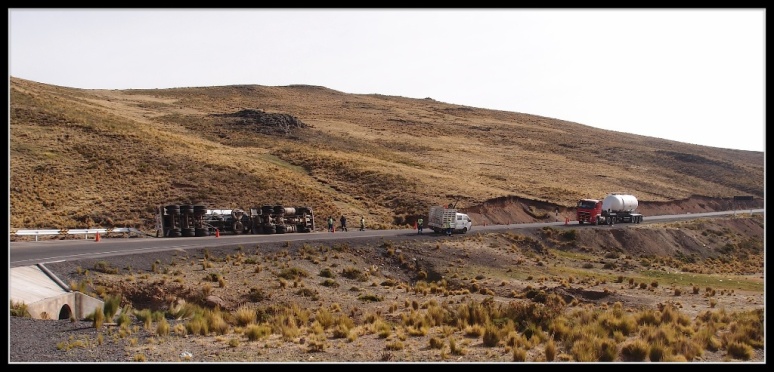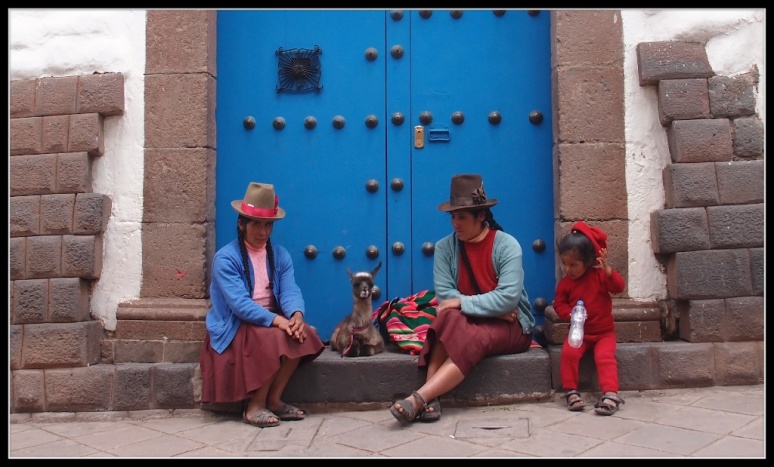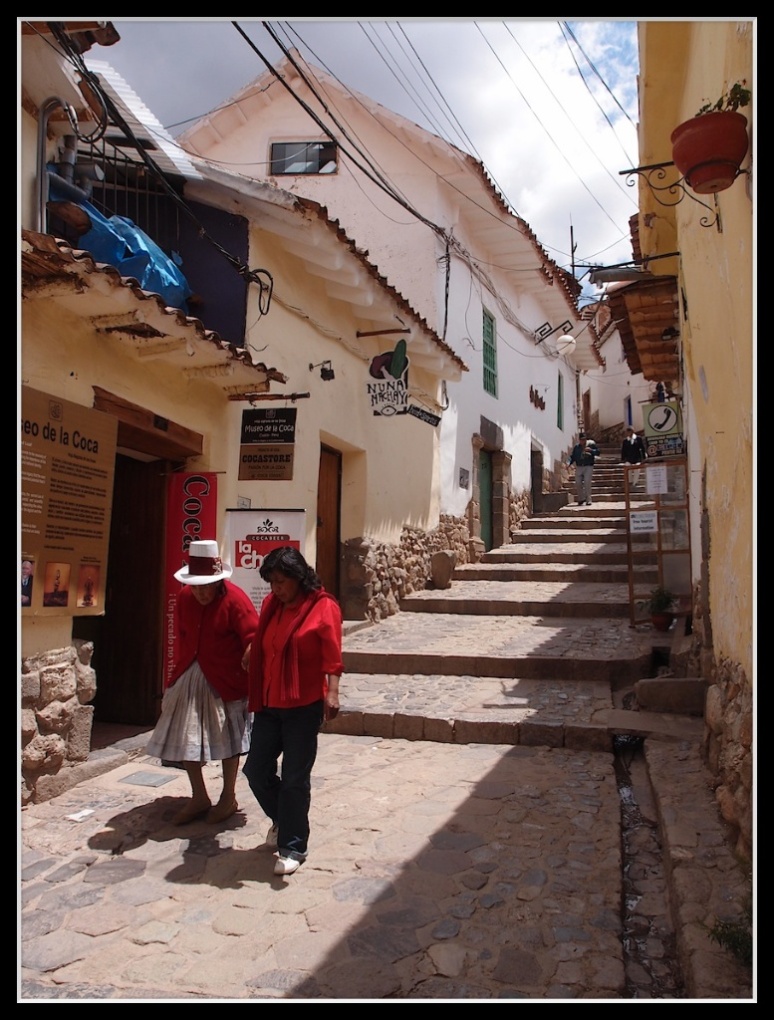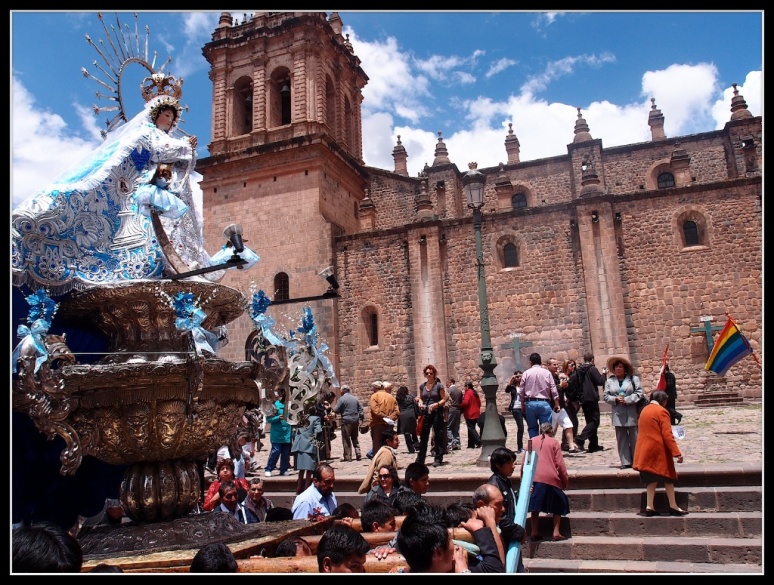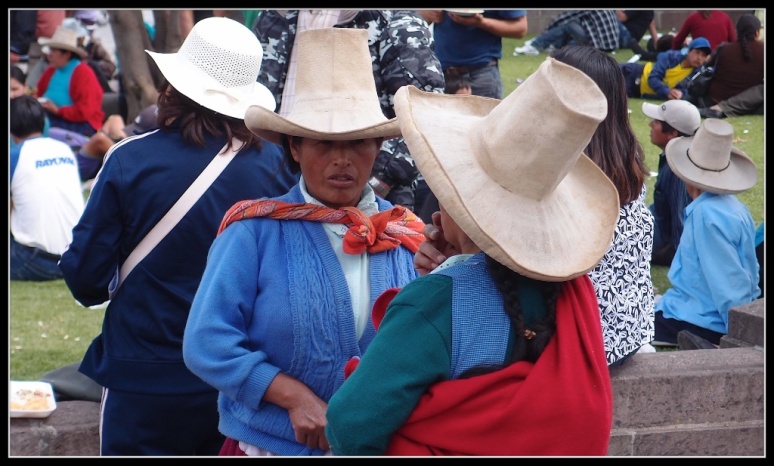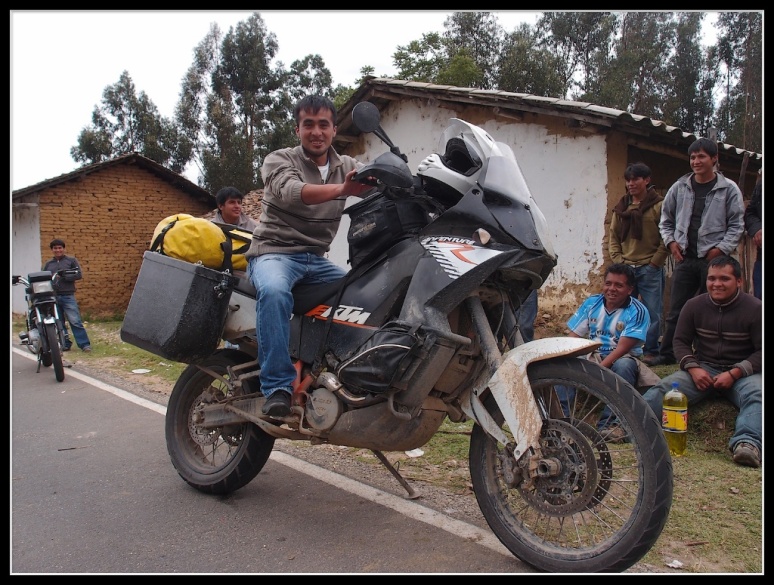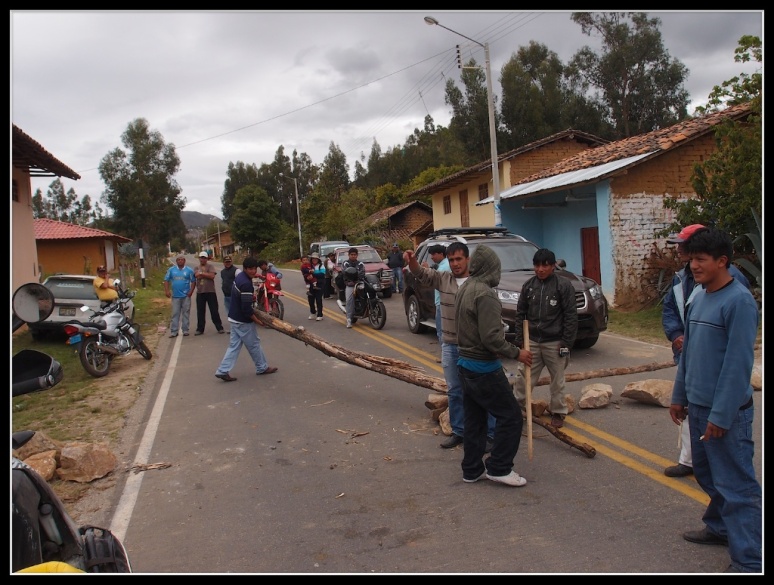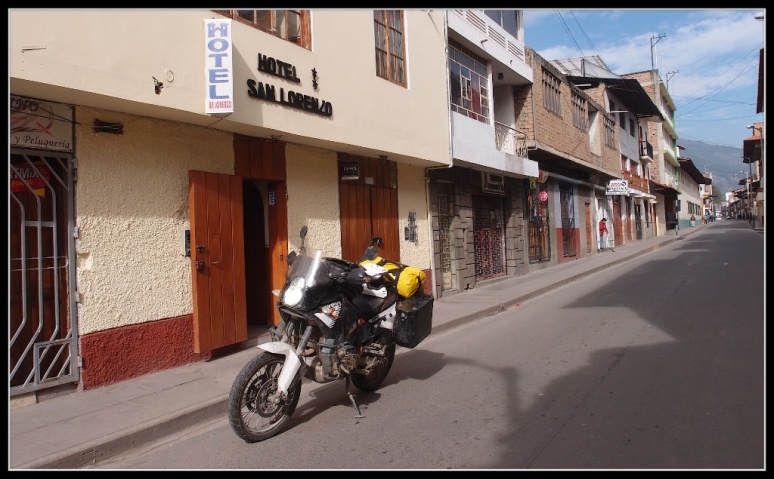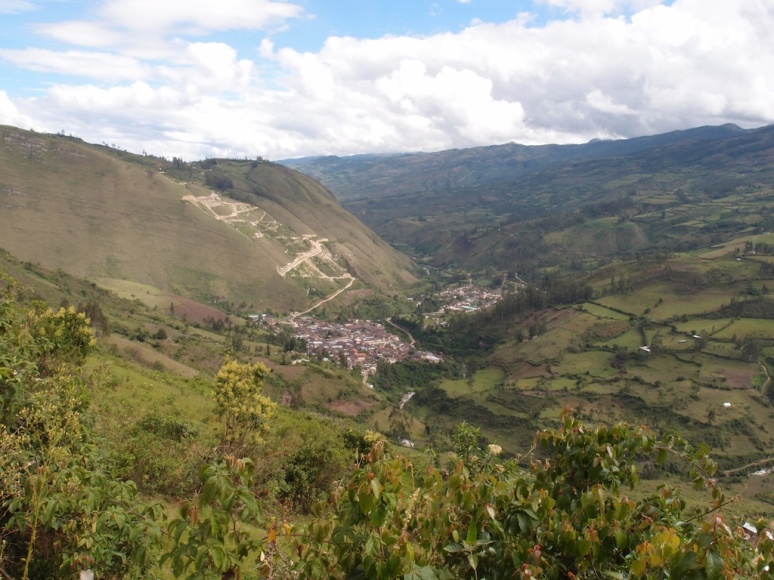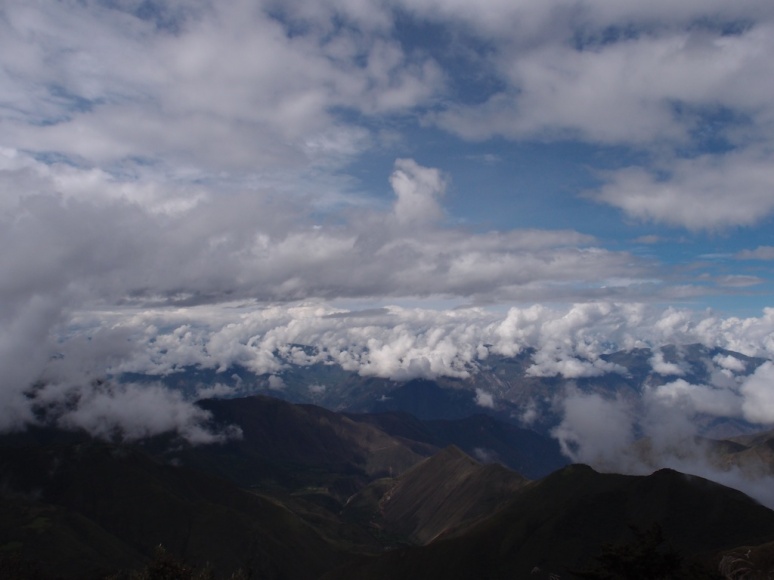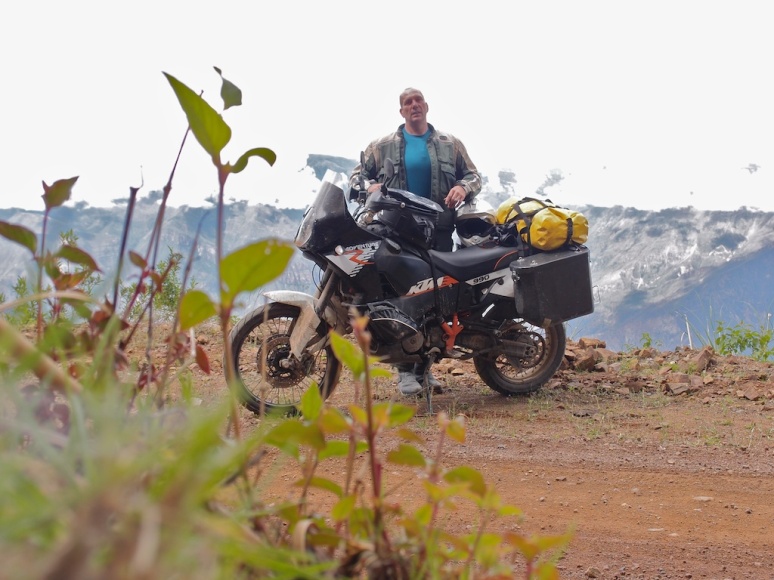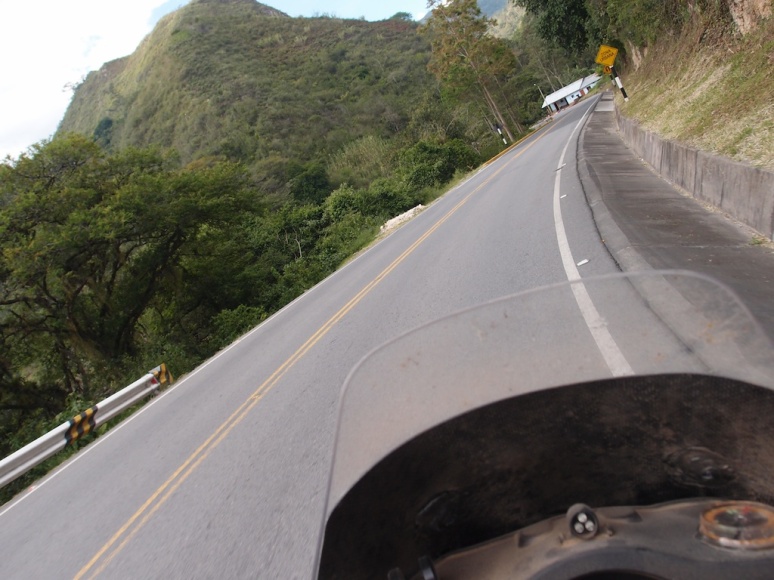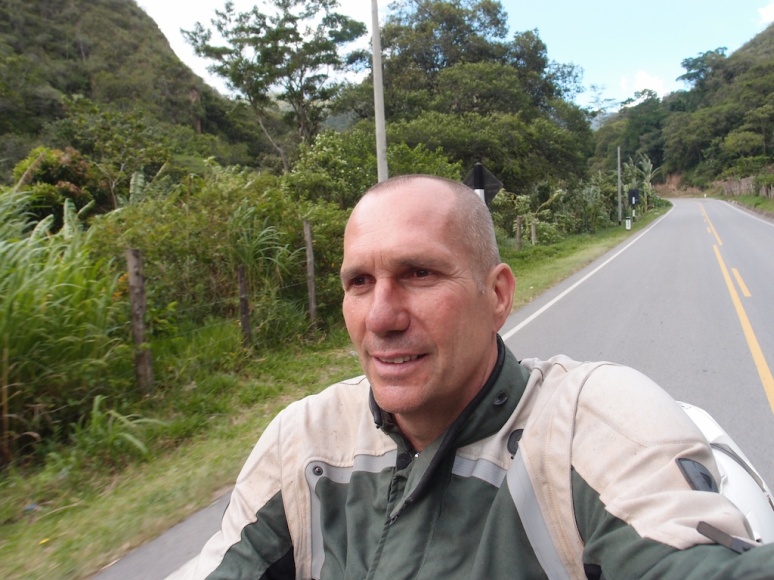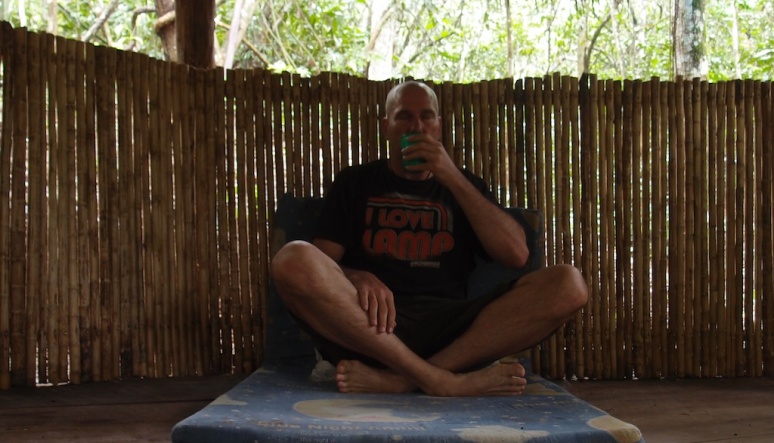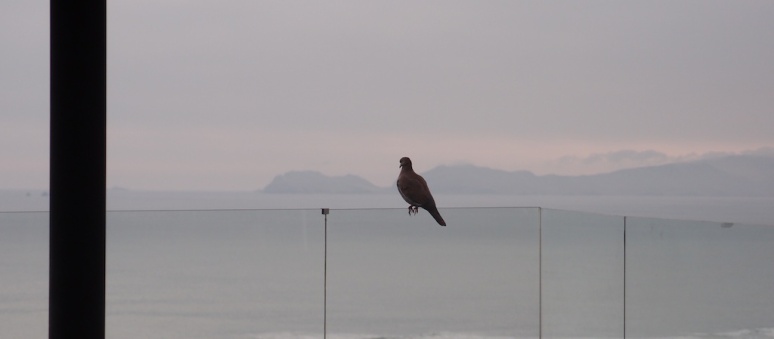Medellin, Colombia
In Bogota the bike gets it’s overdue service at Sebastian’s, a very helpful and competent guy. Here I also get a new rim, my favorite choice of all, a Dirt Star 1.85. They just pull one off the shelf. Happy me, Wish I’d put one on from the very beginning . Time to leave. I take the windy Mountain road from Bogota to Medellin. I heard only good things about Medellin.
Lunch stop on the mountain road:
The road is packed with trucks and busses but still a beautiful ride. Half way through there is a traffic jam for many kilometers, no go. I ride past it and at the head of it I see the reason for the jam: Two trucks crashed into each other. Once I’m past it the road is empty of traffic and offers me turn after turn after turn of pure fun. Yezz! Late that day I arrive at the ‘Black Sheep’ hostel in Medellin exhausted. I love the climate here, t-shirt and shorts weather. Kelvin the owner is a Kiwi and runs his hostel perfect. Enough freedom to enjoy and enough rules to make it work for everyone. I still feel exhausted after a few days, feel a little pain in my chest and cough more than usual. A visit to the hospital gets me the diagnosis of exhaustion and a macka treatment for the next month to basically strengthen my immune system. I did not connect the dots but my aunty Christa did via remote diagnosis: Lung infection. It takes me almost 3 weeks to recover and gather enough energy to move on. All the bike needs is a fresh rear tire, a Mefo Super Explorer and a new hub. Nico, the local KTM dealer orders one and offers me a complete wheel from one of his bikes so I can ride on in the meantime. Thank you Nico. I head north, 2 days riding in warm weather takes me to the northern caribbean coast of Colombia and a town called Riohacha. Not a nice place to stay but the gateway to the Guajira desert that borders Venezuela. I leave early, hit the dirt soon after. It’s a 100 km dirt highway right through the middle of the desert with access roads to different areas branching off. I cruise at 130 km/h and enjoy the heat, take the the turn off to Cabo de la Vela, a famous tourist spot. From here on it’s riding firm desert ground, no roads and the compass becomes my best friend. Just keep the needle pointed to north-west and we’ll hit the beach somewhere.
At the start of the dirt highway into the desert:
And further in:
I get to Cabo but am a little disappointed by it. Desert meets ocean kind of beach in an unspectacular way, a few huts and a kite surfing school. I really don’t get the hype about this place and ride on after a nice lunch, fried fish. Back to the main dirt road it is. Easy. Except I get totally lost for about an hour trying to go back the same way I came. i decide to just follow the needle east no matter what, come past a small community where a helpful woman points me in the opposite direction. More confusion. I go south for a little while and then head east again until I can see the power lines running along main dirt road. Sigh. Back on it and further north we go, the road turns into a deep sand trail but we make it to the tip of the desert, to the beach. Then it starts raining and the further I go the more slippery it gets until there is no going forward anymore, too deep a sand, too slippery. I turn around, work my way back to the main dirt road and head back to Riohacha. The next day I take the sealed road along the coast to Santa Maria but when it starts raining heavily I spend the afternoon and night at a hostel in Palimero, an hour away from Santa Marta.
In Santa Marta I meet those same riders I met in Manaus, feels a bit like a traveling circus. We have lunch and part. The road to Cartagena is a pretty boring one, straight and packed with trucks and cars. Here I stay for a few days, walk through the beautiful historic town, visit a museum and enjoy a real coffe from a proper espresso machine.
Coffe, here we go. Colombia produces one of the best beans in the world. One can get a cup of coffe everywhere, at the petrol station, at street merchants even at a pharmacy and everyone drinks coffe. But, no sorry, BUT this is filter coffe saturated with sugar kept in a thermos. That is the colombian coffe drinking culture I’m sorry to report so. I really have to look hard to find a cafe in Cartagena that operates a espresso machine. I found one in the historic town. There is one exception though, Juan Valdez has cafe chains in big cities and they make excellent coffe.
I head south along the coast for the next 3 days to make my way back to Medellin. The sealed road gets rough, very rough with big pot holes and many unsealed sections. Coming out of a village in nice long left turn on good surface going ca. 80 km/h the bike starts shaking heavily, I bring her upright a bit til I run out of road, lean her back in a little, up again til she stops. The rear tire is flat. This happened so suddenly, no warning. I roll back to the village, stop at a tire fixing place and see what happened. She picked up a nail with the rear and this busted the tube into thousand pieces. That’s why the sudden loss of air and control.
I have a spare front tube with me which would work but those guys manage to get a proper fitting tube in a short time. Thank you guys. I get closer to the border with Panama now and contemplate riding a dirt road north into the Darien Gap, very close to Panama. I flag the idea and get to Medellin the next day only to learn that this is still an area of high FARK activity. Drugs and guns. Thank you intuition.
On the way back to Medellin, wild horses and later lush bush again:
I get back to the ‘Black Sheep’ and have a little break. Time to check out Medellin, it’s techno clubs, art and Pablo Escobar’s place.
Through Venezuela to Bogota
Ok , Guillaume and I leave Manaus in a hurry since I feel a tad uneasy about ripping out the gate to get my bike back. North it is for 2 days, basically a straight highway through rain forest and indigenous reservoirs with big signs saying: ‘Please no stopping, photos, videos, rubbish, hunting.’ Damn, I so wanted to hunt a jaguar with my leatherman. I see small groups of indians walking along the road with spears and bow and arrows, sorry no photos. Guillaume leads, sitting at around 120 km/h max. It’s driving me nuts, I need to get used to it though since we’ll be riding together for the next 9 days. This is a straight highway, good surface, no traffic, I’d be cruising at 150+ km/h. I get used to it though but still try to push him with questions like: At what speed is the old lady red lining? You got good wind protection? What’s her max speed? Fuel economy ok at higher speeds? This quality choice of questions adds another 5 km/h to our cruising speed. At our first lunch stop I notice I really enjoy his company, we talk about bikes, girls, past experiences and more bikes. Man stuff. Nice.
Lunch stop:
Further north the landscape gets less bushy and some cattle farms appear:
We cross the border to Venezuela. Easy. Except Guillaume needs to come back the next morning and buy bike insurance to get the custom temporary import paper. I on the other hand present my health insurance paper that has the beautiful word ‘Worldwide’ printed on it and it gets accepted as my bike insurance, like at all the other border crossings before. We stay the night at the border town, buy fuel from the receptionist since border towns are not allowed to sell fuel to foreigners. Talking about fuel in Venezuela, this is heaven. The best quality fuel in the whole of south america at a price of 3 cents a liter. Yes, 3 cents. Practically we fill up 2 bikes and pay one dollar. This creates the perfect environment for big, old cars and trucks from the 60’s to keep running. Venezuela is known for it’s top mechanics because of that. One more thing, money. Venezuela’s Bolivar has an official exchange rate and a street exchange rate for american dollars which is more than twice as much. The key is to bring cash dollars into Venezuela, change them on the street or in shops and get twice as many Bolivars then from a cash machine or bank. Only problem is it’s illegal to bring cash into the country and police do search for it. I hide my dollars inside my helmet and can highly recommend that technique.
The roads are good and twisty, cutting through beautiful scenery over mountains and through valleys. Magic.
We stay the night in a small town along the road, have pizza from the local bakery and sit outside at the main square. Talking to a man, we’re back to spanish now, and being amongst the town life at this evening gives me the impression that the people here are the most ‘down to earth’ people I’ve met in the whole of South America. The man shares his views on politics with me and finishes our conversation with a sentence that sticks with me: ‘My heart for my country is broken in two halves: the one half loves this country and its people, loves the way we live our lives with passion and compassion for both. The other half hates to see where this country goes, with more and more criminals on the street and in power.’ He gives me the names of a few villages along the way where I under no circumstances should stop, not even at a red light. When we ride through those places I understand. It’s rough.
We follow the highway the next day and have a little break just before a huge bridge:
20 min later we stop for lunch, bbq chicken, ask the guy how far the next petrol station is since we’re both running low on fuel. ‘2 hours your way or 45 min back.’ We’re not gonna make it to the next one, we have to go back. Man how I hate this. Coming back to the bridge I notice a small fuel truck parked on the side. I pull over and see Guillaume disappearing into the horizon. I ask the guy for fuel and he helps me out, fills both tanks to the rim. Thanks mate.
I carry on and not far I see Guillaume parked, waiting for me. We never discussed this kind of situation and he instinctively did the right thing: waiting. We turn around, stop at the truck and fuel up Guillaume’s bike too.
From here on we follow the highway west until we get to the border with Colombia. Last stop in Venezuela:
We cross the border into Colombia at Cucuta on a sunday. Bad. We never thought about it but the customs office is closed on weekends. When we leave the customs area a cop pulls me over after he missed Guillaume and insists that I go back to Venezuela and come back tomorrow to get the customs papers. ‘Ok, he wants money’ I think. ‘But you’d also be the first cop in south america that I actually give some, so no!’ 10 min of ‘no intendo, no habla espaniol’ and he lets me go to the nearest hotel where Guillaume waits, not without making sure I understand that there is police controls everywhere and I won’t get far without the papers. This is the worst place I ever spent a night in. The hotel is ok, very cheap, but the village is dirty and looks dangerous, only tumbling weed is missing from the scene. We go out for diner, leave phones, credit cards and camera behind, and witness a street fight right in front of our dining table. This is a place, no the mother of all places to get away from as fast as possible. Next morning we get our papers fast, thanks to Guillaume who also works at customs back in Canada.
At the customs building. I notice a big sign over the entrance saying: ‘Temporary import papers are free of charge. Do not pay any money to the officer.’ Good to know but also a sign that bribery might be quite common in Colombia. Not so as I learn later on my trip.
We get some money in Cucuta since Venezuela left us both stranded for cash and head west towards Bogota until we run out of daylight. Next morning after breakfast we start riding on what is going to be one of the best rides ever. 400 kms of twisty road with good surface following the foot of a mountain range. Then up the mountain to a height that asks for more clothes and hot soup. Like here:
Then down again it gets warmer and beautiful mountain jungle appears:
And up again and into Bogota we go. Cold, big city with noticeably less oxygen. It takes me a few days to adjust. Guillaume organizes the sale of his bike and his flight back home. Ciao my friend, I really enjoyed your company and who knows, maybe one day …
Boat trip up the Amazon
In Santarem I get us tickets for the 2 day boat trip up the Amazon to Manaus. The ticket for the bike is quite a bit more then mine but she get’s her own cabin down in the belly while I hang my hammock here with a few other guests:
The boat is packed with 500 passengers living very close together for the next 2 days and nights but everyone treats each other with respect and so makes the journey enjoyable. I’m a tad paranoid about my belongings, heard stories of thieves traveling up and down the river going after their business so I lock all my valuables in the panniers and store them with the bike down in the belly of the boat with all the other goods that need to go upstream like bananas, potatoes, onions, rice, etc. The bike goes down through a hole with the help of ropes and man power. I got myself a 1000 pager called ‘2666’ from a south american author for this trip, a recommendation of Juan, a friend from the robbery in Salvador and a journalist. I never listen to you again Juan.
We leave Santarem early afternoon, it’s a relaxing 2 days and night and a joy to travel slow for a change. I let the photos document the trip:
Leaving Santarem.
Approaching Manaus:
Unloading the bike:
Hello Manaus, here I am. I put the panniers on and ride off the docks to the market square of Manaus. I look for a cafe but all I can find is a ice-cream shop so ice-cream it is instead. Sitting there and watching the locals walking past I notice a guy waving at out of his car window. He hops out, comes over to me while his car blocks the traffic on the main road. ‘I’ll be back on my motorcycle in 20 min, just need to drop off my girl friend’ he says. ‘Ok, see you in 20’ I reply. Sure enough 20 min later he shows up on a v-strom 1000 and takes me to a good hostel that’s famous in the rider crowd. ‘Tonight we go out for a beer’ and he leaves. There’s a green KLR 650 parked outside the hostel and her owner Guillaume from Montreal cleans the chain. I check in, later talk to him and it turns out we wanna do the same road north and then cross into Venezuela. We both share the opinion that Venezuela is a pretty unsafe place and we decide to travel together, leaving in a few days. This will be the first time I ride with someone else. Then I bump into 4 other bike travelers walking down the road and we all go and have a great diner at a street-side bbq plus a few beers. We share stories of our travels and I learn how we all have different ways of traveling and different bikes and how it all fits with each one of us. A couple of days later Guillaume and I leave Manaus. Actually want to leave since my bike is still in the secure parking area on this monday morning. 8.30am and no one there to unlock the gate. I ask around for half an hour and all I get is that the parking lot opens again on tuesday. I try to get the phone number of the manager without success. Muscles it is I decide and carefully rip the gate out of its concrete hold while people walking past are watching. I get the bike out, ride to the hostel, mount the panniers and my bag and tell Guillaume to hurry up. We’re leaving Manaus, heading north towards Venezuela a thousand km away but I’m leaving with a feeling of unease and guilt. This is not the impression I wanted to leave in Manaus. I’m sorry gate owner. Ok, two more days riding in Brazil it is before Guillaume and I will enter Venezuela.
Alter do Chao
I park the bike at the market square of Alter do Chao and have a coffee. I start chatting with a guy who moved from the States to Ecuador, set up an organic farm there and holidays now here. He came all the way from Ecuador by boat along the Amazon, took him 2 weeks. Pedro the young owner of the cafe sits with us and offers his home as a stay for me. I’d need a hammock though he says, I buy one from across the road and follow him home.
The view from the market square over the Amazon, the flooded beach and huts indicate a little rain further upstream:
The sleeping house holds 8 hammocks and some nights the place is full with Pedro’s friends or people he helps out a little.
We talk about the state of the world and the local problems between the authorities and the natives and when I leave in 2 weeks I know, after getting to know Pedro, that the world is in good hands. Here is Pedro with his step mom:
After giving the bike a good clean and some maintenance I take the dirt road to the national park. An area of rain forest along the Amazon where only natives live. Here’s the entrance to the national park:
At first there are a few small villages along the road but the further I get into the park the less populated it gets. I ride over a rough hill section with some washouts and stop at the bottom by a bridge to take some shots:
A couple of young guys are out hunting and proudly show me what they shot. Don’t ask me what it is:
And further in we go. It starts to rain, I stop at a little hut and sit under a tree by the river:
A guy in a close by hut waves me over and offer his roof. We have a chat, as good as it goes with my limited portuguese. He lived here all his life, catches fish with a net, grows corn and some root that he dries and he collects rubber of rubber trees:
He offers me a cup of coffe and shows me around his place, I spot a new motorcycle in his shed and ask him if he rides a lot. He says he’s never ridden it, he never left the park, the bike he bought if someone here needs to use it. Wow, talk about the strenght of a small community. I thank him for his hospitality and leave. The rain hasn’t stopped so I turn around to get out. That washed out hill by the bridge sits in my mind, clay and water and uphill is an unhealthy combination but when I get there I just keep up the momentum and throttle easy over it. As usual the problem was bigger in my head than in reality.
Heading back to Alter do Chao in the rain:
Time to chill in the hammock:
This one I took on the iPhone.
Time for my last adventure in Alter do Chao, participating in an Ayahuasca ceremony. Those who followed the blog from the beginning, kudos to your stamina, know I’ve done a few back in Peru. This one is held by Karin, a mastress(?) of ceremony. We prepare the sacred space, clean it, get some firewood and hang our hammocks.
The sacred tea and utensils for the ritual:
After it gets dark Karin lights the candles, puts on some gentle sounds on the stereo and gathers us in a circle. Us is two young men and women from the village and me. We sit quietly for a while, I focus on my breath to stop my thinking mind and when we’re ready Karin offers us the tea. I go first, yes all those who know me please hold back your comments. I sit for quite a while, meditate, nothing happens. I ask for another cup of tea, drink it. It tastes just as bad as the first one, muddy. Again I wait, the others are fully into the experience, they leave the circle to throw up, a cleansing quality of the tea. Physically, emotionally, mind and spirit connection cleansing quality. After a 3rd cup and some more time I can feel some little effects, a lightness in my body and a slight shift in visual perception but nothing like the one in Peru. A little while later I have to get up and purge. Heavily. Repeatedly. We close the circle, I get in my hammock and fall asleep. The next morning I feel refreshed, calm and energetic. We all share our experience and for 3 of the other 4 it was the strongest one they ever had. And they are very experienced in Ayahuasca ceremonies. For one girl it was her initiation into the ceremony. To me this was a very different experience to my first ones and I trust the spirit of the plant gave me exactly what I needed. Thank you Karin for making this ceremony available to me.
I’m ready to move on, pack my stuff and want to pay Pedro the amount we agreed on for accomodation. He refuses to take my money, offers me a gift from the region instead. Wow, what can I say. This is a very special place and it attracts very special people. Thank you Pedro and Alter do Chao for your generous hospitality, your gifts and for showing me your treasures.
I’m off to Santarem now to catch a boat up the Amazon to Manaus. It’ll be her first boat trip and she’s getting excited I can tell.
The famous Transamazonica road
A guy I met a few weeks ago at a motorcycle festival grew up in a village along the Transamazonica. He laughed at me when I told him I want to ride it. ‘No way’ I remember him saying, ‘there is fuel alright but the natives gonna eat you, seriously.’ After I stopped laughing he was still rubbing his belly to underline the seriousness of his statement. Yet 1000 km of dirt through the Amazon rain forest is truly irresistible. But first things first. Sao Luis presents itself as a lovely historic city that could easily be Brazil’s Cartagena, high tourist turn over, if they could only get around to do some renovations. Here some impressions from Sao Luis: 


From here its 2 days west to Maraba, the starting point of the Transamazonica. She played up a bit on this 2 day ride, at times she wouldn’t shift past neutral and I was either stuck in first gear or in the 2-6 gear range. The diagnosis was clear after I consulted the KTM forum on advrider.com: a loose pin on the shifter wheel. I had to open her up, open heart surgery, for the first time. I’m so glad I brought a spare clutch cover gasket cause that one’s gonna get damaged for sure. With the help of a local mechanic I found the faulty bit, hammered it back in place and secured all 6 pins with a punch to the aluminum wheel.
The clutch cage needs to come off too to access the shifter wheel.
Here’s the loose pin working it’s way out of the wheel. Nothing a hammer couldn’t fix. All done, all good. Oil change and a set of motocross tires and we’re ready to bite the dust.
About 20 km west of Maraba the sealed road ends and the Transamazonica begins. There’s quite a bit of traffic on the road, mainly trucks throwing up lots of dust. Time for the goggles. The road is rough, deep potholes and many of them. This wouldn’t worry me too much, at a speed over 90 km/h she just flies over those. The real danger is overtaking trucks, without a warning they virtually jump left and right to avoid those potholes, the driver won’t notice me in the dust cloud behind him despite the high beam light on, the horn honking, and I can’t see much either, throttle is the only solution here. After a few hours riding there’s less and less of those trucks and I start enjoying the scenery. Red clay road and green bush, just what the doctor ordered. What he didn’t order was those wrong sized motocross tires. The rear is way to narrow for the 4″ rim and the front is wrong too. The bike feels like it rides on marbles with a very loose front. I come through a village, pick up a nail with the front tire and come to a still stand right at a tire changing place. Lucky me! I change back to the Sahara 3 and pay for the service with an almost new front motocross tire.
I stay the night at the village and leave early the next morning. What a beautiful road through the bush.
I stop for lunch at this bush pub, a couple of guys playing pool over a beer return my smile. The pub owner also runs a fish farm so fish it is in the typical brazilian way, deep fried. Tastes fantastic and my trans-fat reservoir is full again. Not that it ever got to low levels here in Brazil.
I stop to take a photo and this guy stops too to secure his load. We have a little chat, me mainly listening and nodding due to my very little knowledge of portuguese and then he carries on. Here’s the shot I stopped for:
I make it to Uruara, find a cheap hotel with secure parking for the bike: the hotel lobby/bar/breakfast room.
More awesome dirt road the next day, I was very lucky with the weather, no rain. As the dirt experienced reader will notice, this kind of clay will turn into high quality soap after only a few drops of water but not on this trip, thank god. The change back to the Safari 3 front tire makes the bike a bit more stable and gives me more confidence that I immediately abuse. I let her fly a bit on the straight road where the shadows of the trees seemed the only obstacle. Yet hidden in those shadows sits a rock the size of a soccer ball that I only notice because I hit it front on. Never saw it. I know straight away it was bad and hope, while coming to a stop, for the front rim to be at least rideable.
Lucky me, the damage wasn’t too bad on this 3rd rim, it holds up well til Bogota. The rear has a different problem though:
A cracked spoke housing on the hub and two hairline cracks in the neighboring housings. Well, it’ll be ok with one loose spoke, lets see how long those other two will hold. I definitely need to take it a bit easier from here on until I get that fixed, Manaus hopefully. I’m thinking of getting the hub welded there. Not far and I take the turn off north to Santarem which turns into a good sealed road for the next 200 km. That’s so strange, 200 km of tar sealed road from dead end Santarem to the dusty Transamazonica. I can’t get my head around this one. I arrive in Santarem, a hot and busy port town and leave after a coffe towards Alter do Chao, a cute quiet village someone recommended to me, only 35 km away. Here I stay for a little while, meet some nice and interesting people, visit the close by national park and take part in another Ayahuasce ceremony. More about that later.
Jericoacoara, riding the beach
Access to the small fishing village of Jericoacoara is via a good dirt road plus public 4WD transport only. Except for dirt bikes, they can opt for a 20 km dirt road to another village and then ride the 5 km long beach to Jeri. You guessed right, option two it is. Mostly fun, just the few deep sand bits need some support from the feet. Jeri is surrounded by dunes in the south and the Atlantic ocean in the north. Some of those dunes come right up to the waters edge.
Without the luggage, just map, water, tools and the good advise from a local biker to deflate my tires to 12 psi at the front and 15 at the rear I head west for a 100 km day trip along the beach and through the dunes.
 The early morning beach at low tide. A good time to start the ride, as soon as the sun comes up it’s getting hot and I sweat a lot in my riding gear.
The early morning beach at low tide. A good time to start the ride, as soon as the sun comes up it’s getting hot and I sweat a lot in my riding gear.
 A dune right on the beach front, two extremes meet, desert and ocean.
A dune right on the beach front, two extremes meet, desert and ocean.
 The low tide provides a wide and firm track. I get a feeling for the ground and push the bike past the 100 km/h mark. She’s solid as a rock. I look for changes in the color and structure of the sand to stay on the firmer path, it’s a bit like skiing. Then I hit a bog hole at about 100 km/h, the bike sinks in a foot and slows down, I throttle up but she keeps slowing down and lucky after ca 100 m the ground becomes firm again. If I would’ve gone any slower I would’ve been stuck there.
The low tide provides a wide and firm track. I get a feeling for the ground and push the bike past the 100 km/h mark. She’s solid as a rock. I look for changes in the color and structure of the sand to stay on the firmer path, it’s a bit like skiing. Then I hit a bog hole at about 100 km/h, the bike sinks in a foot and slows down, I throttle up but she keeps slowing down and lucky after ca 100 m the ground becomes firm again. If I would’ve gone any slower I would’ve been stuck there.
 I stop at at hut and get a fresh, cold drinking coconut. The bike is the center of attention there, tourists check it out and even the donkey gets excited looking at it. I understand.
I stop at at hut and get a fresh, cold drinking coconut. The bike is the center of attention there, tourists check it out and even the donkey gets excited looking at it. I understand.
 Even at the end of its life the Mitas grip pretty good in sand. Much better than a new Pirelli MT90 as I find out later.
Even at the end of its life the Mitas grip pretty good in sand. Much better than a new Pirelli MT90 as I find out later.
 Through the dunes I get more deep sand practice and this time I throttle up a bit, stand up and bring my weight back. In the deep sand without any ruts the bike feels under control and stable at around 70 km/h, a bit like skiing fresh, deep snow. Only on the track where the buggies drive it wants to follow the ruts. I’m getting a bit more confident in the sand now. Fun in deep sand except for the ruts.
Through the dunes I get more deep sand practice and this time I throttle up a bit, stand up and bring my weight back. In the deep sand without any ruts the bike feels under control and stable at around 70 km/h, a bit like skiing fresh, deep snow. Only on the track where the buggies drive it wants to follow the ruts. I’m getting a bit more confident in the sand now. Fun in deep sand except for the ruts.
 A barge takes me across a river.
A barge takes me across a river.
 Through a mangrove forest with deep sand and ruts.
Through a mangrove forest with deep sand and ruts.
 At the end of the 50 km beach and dunes ride awaits a ferry to connect to another village but for me it’s time to turn around and do it all backwards. I drank 3 liters of water and did not have to pee once, I sweat it all.
At the end of the 50 km beach and dunes ride awaits a ferry to connect to another village but for me it’s time to turn around and do it all backwards. I drank 3 liters of water and did not have to pee once, I sweat it all.
 Leaving Jeri I left the tires down at 12/15 psi until I hit the firm dirt road.
Leaving Jeri I left the tires down at 12/15 psi until I hit the firm dirt road.
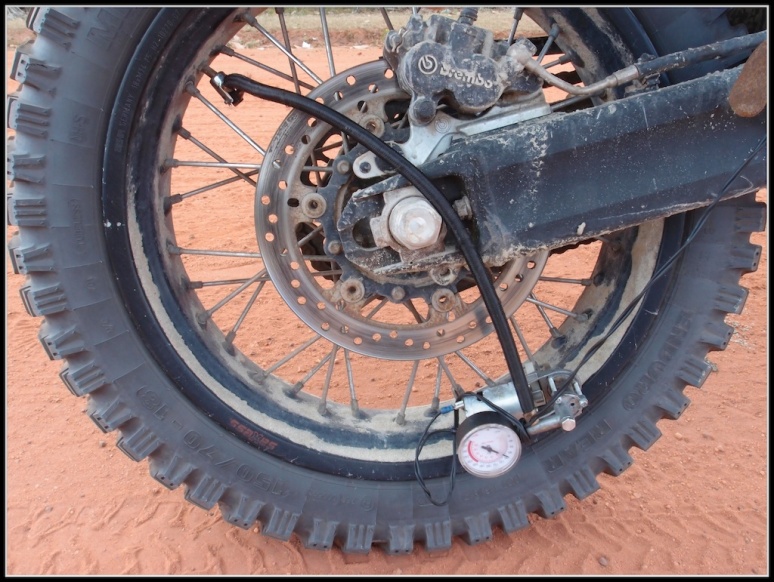 Back to 25/25 psi for this kind of road.
Back to 25/25 psi for this kind of road.
I head west towards Sao Luis. The dirt road shown on the map turns out to be impassable in one spot with my heavy bike and luggage, a 50 km stretch of deep sand even the locals on light bikes don’t ride makes me take a 100 km detour on dirt and ridable sand.
 This is a pretty remote road, only a few houses along the way. I make it to my next stop in Barroquinha with the last light.
This is a pretty remote road, only a few houses along the way. I make it to my next stop in Barroquinha with the last light.
After 11,500 km the tires are at their end. I change them to the Pirelli MT90 rear and a Metzeler Sahara 3 front, the only choice I have here in the north of brazil, and take the sand road to the dunes of Barroquinha. 500 meters into the deep sand I give up and turn around. There’s hardly any grip on the rear and I need to push the bike under throttle out of the sand where I easily rode through only a day ago on the dead Mitas. Lesson learned.
Good news though, I meet a guy who just took a bus from Santarem, halfway up the amazon, to Belem at the mouth of the amazon. There is a road on the map from Belem to Manaus in the middle of the amazon called the Transamazonica but all my research showed its undrivable even in the dry season. The good news is that at least half the road is drivable, from Belem to Santarem. Over 1000 km of dirt and as long as the rain holds out and there’s some fuel along the way this part I will ride. Then take the boat to Manaus. I got myself some proper motocross tires here in Sao Luis for that stretch. It’ll be a while before I have internet access again I guess. Boa noite amigos.
Lencoise and the Chapada Diamantina National Park
The 400 km ride to Lencoise is uneventful, a highway packed with trucks going both directions. Lencoise itself, the gateway to the national park, is a beautiful historic village, cobblestone roads, old and colorful one storey buildings and alive with locals and tourists. The map shows a 30 km dirt road as the beginning part of nice loop for a day trip. With the luggage left at the hostel the bike feels so much more responsive. The dirt road is a bit more challenging then I expected, steep rock sections are good fun but the deep sand on both sides of the river crossings are hard work. I wish I had some sand riding training cause the key is speed, standing up and weight back. It’s just that the bike goes all over the place in the deep sand and it goes against my sense of safety to speed up when the bike is out of control. I air the tires down to 22 front and 25 rear and that helps a little but am exhausted at the end of the dirt/sand road.
 A little waterfall at one of the river crossings.
A little waterfall at one of the river crossings.
There’s a grotto I like to visit, 20 km of hard packed dirt, yes that’s the kind of dirt I love. A guide takes me to the grotto and I get to swim in it. The sun hits the water at around 1 pm and lights up the grotto but I was a bit to late to see that.  The grotto.
The grotto.
The next day I take the bike up a valley past a small village and hike up a mountain to the famous Fumaca Falls. 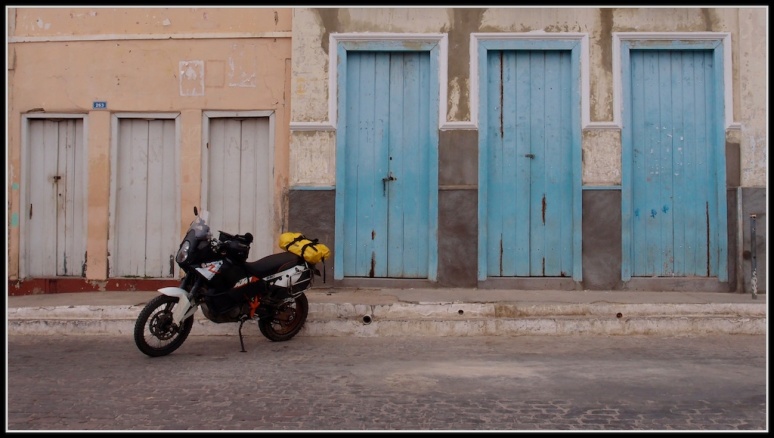
At the end of the high mountain plateau awaits a stunning view over the canyon and the falls that get their name, smoke falls from the fact that the water never reaches the ground some 300 meters below, it just evaporates.  The canyon.
The canyon.
 A curious guy follows me around.
A curious guy follows me around.
 A beautiful flower on a small bush.
A beautiful flower on a small bush.
 This high plateau creek is the source of the waterfall.
This high plateau creek is the source of the waterfall.
Time to move on. North. To Recife. I do need new tires, the Mitas have almost 10,000 km on them, twice as much as I usually get out of the rear one.  Riding through a bamboo forest on the way to Recife.
Riding through a bamboo forest on the way to Recife.
The vegetation gets more lush as I move north along the coast. Spot the dragon!
Next planned stop is Jericoacoara on the north coast of Brazil. A magical place where I get to practice more sand riding.
Salvador, at the wrong end of a gun.
Salvador is a good 700 km away, I decide to stay the night in Itacare, a lovely fishing village that connects to the highway via a 50 km dirt road. I follow the meandering river, come across a gaucho on his horse who is kind enough to pose for a picture.
Some parts of the road turn into deep mud, the tires get covered in it and I have to use my feet as support to keep the bike upright. Thanks to the higher mounted front mudguard the wheel keeps turning and I make it through the mud without crashing.
The next day I reach Salvador, book myself into a nice hostel, Galeria 13, and am glad to meet english speaking people. I have diner with Ferras from Australia and Juan from Buenos Aires. They tell me that what I’m doing is what they want to do in 5 years time, motorcycling around south america, and over a beer we become friends and make a pact to meet for christmas 2016 in Ushuaya, the worlds most southern town in Argentina, on our motorbikes.
Hostel Galeria 13 in Salvador’s historic center.
The next day we want to take a bus to the shopping center, they need presents for their families back home and I need a good book for the 5 day boat trip up the amazon.
150 m down from the hostel, still well within the ‘safe area’ of Salvador’s historic center flooded with cops we wait at the bus stop. It’s lunchtime on this sunday, the wide road with it’s closed shops is absolutely empty, not a single person as far as I can see except for one woman waiting for a bus.
Ferras looks something up on his iPhone, we just stand there waiting for the bus when two guys, a ca. 30 year old in a bright orange t-shirt and a young teenager, cross the road and talk to the woman next to us. Then the older guy comes over to us, grabs Ferras’s phone from his hand all very slowly and quiet, not a word’s been said. Ferras moves his hand towards his phone in the orange t-shirt’s hand and says: ‘hey give me my phone back!’ Orange t-shirt steps back and puts his hand on his gun which is in his belt at the front. He says: ‘I have gun.’ It’s all very surreal, very quiet, no yelling, slow movements from the robbers. Orange t-shirt keeps a couple of meters of distance between us, teenager searches Ferris’s pocket, gets his wallet, then his watch. Orange t-shirt eyes up my camera which I wear in a case on my belt. I can’t think straight, none of the warnings I read about what to do in such a scenario enter my conscious mind. All I can think of is along fight or flight scenarios. Grab the little guy and use him as a shield is one the fight thoughts crossing my mind. Thankfully Ferras stays calm once he realized a gun is involved. Orange t-shirt focuses on Juan’s shoulder bag but Juan holds on to it with both hands and starts yelling ‘no, no, no!’ and walks around. I start walking away, my back turned to the mugging and a second later both guys run away. We’re overwhelmed by what just happened. Tons of adrenalin rushing through my veins, feelings of relief, anger, being victimized. Thoughts of did we act right?
Reality for me is I did not act, I re-acted to the scene arond me, I wish I could’ve been more conscious but the odd reptilian brain with it’s only function of fight or flight took completely over. In the end we are safe and only one of us lost his belongings, I know Ferras, it’s not much comforting for you my friend.
The three Muggedtiers: Ferras right, Juan and I.
Later we learn from the hostel owner that no tourist has been shot yet in a mugging in Salvador. Still, with so many crack addicts in town, in the streets, this doesn’t count for much. Salvador is co-hosting the soccer world chamionship in 2014. It needs thousands of armed police in the streets to make it safe. Good luck Salvador.
I just gotta get out of here now! Off to Lencoise and the Chapada Diamantina national park, the polar opposite to Salvador.
Heading north from Rio
Rio was nice for a little break and felt really safe. I head towards Buzios, just 200 km north of Rio and find a beach village heavily geared towards tourism. I notice that I’m less and less interested in touristy stuff and more into off the ‘Lonely Planet’ map areas. Someone should write an ‘Anti-Lonely -Planet’ guide.
Buzios on the Atlantic coast.
I stroll along the beach front and come across some unusual sculptures:
Some short lived ones, and
some bronze ones built into the sea. They look so real from a distance, only the occasional seagull landing on their hats gives away the static nature.
Over breakfast I talk to a guy, turns out his brother owns the same bike as mine and he informs me that there’s a big motorcycle festival on in Guiri in a few days. That’s on my way north so I decide to go there via some much loved dirt roads.
KTM heaven, and mine. I just love riding those dirt roads. This one to the left will take me through fogy hills into coffee farming country. I just need to watch the weather, when wet those roads turn into soap. The Mitas tires are holding up great on the dirt, best 50/50 tire by far and they also last a lot longer than anything else. Kudos to Mitas.
Just like me, my baby loves being close to coffe.
Those berries are ripe and ready to be roasted. Now I’m hanging out for a good coffe.
Back on good asphalt I head north. I come up to a cop car on the highway flashing it’s lights silently. They all do in all of south america, even when parked for a lunch break. Seriously. I follow him for a minute going 90 km/h on a good highway. Then he speeds up, he must have seen me and decides to let rip a bit. We’re chasing the road at 140 km/h, some wide curves, a bit faster on the straights. I manage to keep up with him. 20 minutes through traffic free countryside, then we reach a village, slow down a lot. At the red light he puts on his horn and and flies through it. I stop, ciao amigo.
Guiri is right on the beach, the main square is cordoned off with security diverting traffic around it. Except for motorbikes! They all gather at the big square. I park the beast and soon people start talking to me, where are you from, where’re you going to, and soon the organizer hands me prize for the furthest traveled biker. I give an interview to the local radio station with the help of a translator and feel truly welcomed. Quite a few guys take photos with them, me and the bike in it.
Next stop is Salvador where I’ll find myself on the wrong end of a gun.
Brazil, Rio de Janeiro
I make it to Rio and find a nice and quiet hostel with a good mattress, clean bathroom and a nice breakfast. I’m not that excited about a big city but feel I need to give Rio at least a couple of days to show me some sights.
Off to visit big J on top of a hill overlooking the city.
A breathtaking view over the lagoon.
Nestled between green hills and famous beaches Rio seems to have it all and the people I see enjoy living here.
I enjoy a stroll through the big botanical garden and so do many others on this saturday.
Then I walk to Ipanema beach where that girl came from the whole world sings about. Lots of sunbathing and beach sports here.
And then the next beach I walk to is Copacabana. It’s nice to see the locals enjoying their beach on a saturday, families hang out, play, eat, drink and socialize here. The evenings I stay at the hostel, don’t feel like going out so no reports on Rio’s famous nightlife, sorry.
It rains sunday and monday which gives me the perfect opportunity to update my blog. So here it is, updated from the beautiful Rio on a rainy day. Or two. I’m off tomorrow , north along the coast if the weather allows.
Brazil, Sao Paolo, Parati
Three days on the asphalt is all it takes to get me from the west border of Brazil to the east coast. I could have taken more time and ride smaller roads which I usually prefer but I wanted to get the new rim mounted asap plus I was hanging out for beaches and the sea. I get to Andre’s shop in the afternoon and he completely takes care of me and the bike. He finds me a place to stay and we go through the parts he ordered in from the states. A few customers on 990 KTMs come for a visit and are curious about my trip.
Andre on the phone to find a fitting rim.
The new rear shock rebound adjuster, a tiny screw that seized in Peru and left me with the rebound setting as it was. With the changing weight on the bike, with/without luggage, on road/off road, I missed this feature. He’s got the right part and his brother Marce manages to loosen the old bit with heat, hammer and oil and gets it out while servicing the shock. Two new blinkers replace the blind and broken rear ones, an oil change and some lost bolts getting replaced. The exhaust fell apart again and Marco cuts it back into shape and rivets it again, this time with inox rivets. I used aluminum ones and they just vibrated off after a while.
Marce rivets the exhaust, this time it gets proper inox rivets.
The rim. Andre has a 1.6″ narrow A60 but it won’t fit the spoke pattern. He offers a DID front rim from his shop 690. I’m happy, it’s a good rim 1.85″ wide, my preference. We take it to a wheel specialist to get it mounted and aligned, only to get it back an hour later cause the spoke pattern doesn’t fit either. Andre makes a few phone calls just to find out there is no fitting rim in Brazil. One of the visitors, actually two of them with 990s offer their rim and are happy to wait 3 weeks for a new one to arrive from the states. Wow. I don’t know how to thank you enough my new friends, really. And while we’re at it can I have your chain guard too? mine is totally shot. ‘Of course, no worries mate.”
Andre takes the rim and chain guard of a generous customers donor bike.
I’m happy, very happy to be able to carry on. Andre, Marce and the crew at Mult Racing are the best mechanics I ever came across. The bike got taken apart, cleaned completely, worked on and fixed to the highest possible standard. Andre dominated the national brazilian endure race scene as a pro for many years and now offers his knowledge and attention to detail to his customers. Lucky them! And lucky me.
Andre, Marce, 2 mechanics and the black prince, a master bike cleaner. Thank you Mult Racing team.
I leave Sao Paolo behind, actually I did not visit the city at all, I want to see smaller towns and villages along the coast.
The road from Sao Paolo to the coast.
Off to Parati, a small town with a historic center that han’t changed much in the last few hundred years. Cobble stones and horse cars, whitewashed mediterranean single store buildings and a beach front with access to small islands makes this place a highly sought after destination. Here meets a mix of local people, brazilian and international tourists and yet the town manages to keep it’s character and charm.
Parati’s historic center.
Sweet treats from a cart in the street.
More of the mediterranean flair.
Nearby in the hills, a church built on top of a massive rock.
Behind that church is a little waterfall tucked away in the bush offering a natural water slide. It was fun but this guy definitely got more speed going than me. Here I meet Brice, a canadian living in Colombia, who got me a bit off the idea of riding through Venezuela. We shall see.
Only 20 km south of Parati lies this beautiful, quiet little village of Trindade with its magic bush and big beaches. Here I enjoy the stillness in the bush, read a book on the beach and give the word ‘chill’ a new meaning.
I was so chilled out that I only took one photo in Trindade. Fish drying on the beach.
Brazil, Foz de Iguazu, Bonito, Pantanal
I arrive in Foz de Iguazu after a cruisy ride, it started raining just the last few kilometers. The exhaust seals blew, she’s very noisy. The two young hosts at the ‘Blue house’ hostel welcome me warmly and one offers to help find new seals. First shop has the right ones and I get two spare ones, just in case. I seems ever since I changed from a 2in2 to a 2in1 exhaust system to make room for an extra fuel tank she blows those seals every 10,000 km. Probably not enough flow through only one pipe. Back at the hostel the owner helps me putting them in. Thanks mate.
Off to the brazilian side of the Falls today:
Iguazu Falls from a distance.
Wildlife asking for food.
The next day I visit the falls from the argentinian side, a much closer experience.
Butterflies gather around a little puddle.
Right above the falls.
The roaring thunder of the falling water, the saturated warm air and the abundance of plants and animals at this place make this a magical experience. Being at this place where mother nature goes wild feels like a gift.
Off to Bonito, a two days ride on good asphalt. What attracts me to this place is the little river ‘Rio do Prata’ with its crystal clear waters, an abundance of tropical fish and the opportunity to drift dive down this little gem. A guide takes me as part of a small group to the source of the river and lets us get into the water with the warning not to pee into it, it’ll attract anacondas. We start floating down with the current to see this:
Bonito has many more things to offer, nature walks, water falls, bird watching and other outdoor activities. The thing is though that everything is located on private land and can only be visited by organized guided tours. Not quite my cup of tea. Ciao Bonito, I’m off to the Pantanal area.
The Pantanal, a huge wetland area is saturated with wildlife that’s easier to see here than in the overgrown Amazon. I’m hoping to see a jaguar. I base myself in a town at the south end of the Pantanal, Aquidauana, and ride into it on fantastic dirt roads. One is called ‘Estrada Parque’, 140 km of firm sand and many bridges. I stop at a spot where I can overlook a small lake:
A Capywara sunbathing. It just sits there not moving at all even with Caymans coming up close.
A Cayman
I take the ferry over a River to carry on towards Curumba to get fuel and lunch.
After we both fueled up I take the same road back. 20 km into it there’s a noise coming from the engine i think. I stop, can’t quite figure it out what it is, I loosen the chain a bit.
Back riding the noise is still there. Sounds like the chain, I stop and check again:
That’s it. She spit a few rollers. Not good. The chain has only 10,000 km on it, so have the sprockets. Plus I look after it, oil it every day. I’m not sure why this happened but it wouldn’t help right now anyway. I turn around and ride slowly back to Curumba where I find a good mechanic. Friday afternoon, he’s on the phone straight away to find a chain. There is one in Sao Paolo but it will be wednesday til it’s here. He gets me on the back of his bike, we ride over the border to Bolivia where he has a friend who owns a fishing tackle shop, he can help Christiano says. His friend rings around and promises the chain and a rear sprocket will arrive on the bus from Santa Cruz on sunday morning.
And so it does, original KTM, plus only half the price of one from Brazil. Christiano puts it on and sunday after lunch I’m on the road back to my base in Aquidauana.
Some gauchos moving cattle.
On the way I do some dental work on roadkill.
The next day I take a friend on the bike into the Pantanal on a different dirt road. 50 km into it a storm comes up, then heavy rain turns the red clay into soap. It takes me 3 hours to get back out and feel lucky we stayed upright.
One of the many bridges on the way into the Pantanal.
A few cattle farms along the way.
The rain makes it easy to decide to turn around.
The road back into town gets a bit flooded.
The next day I take the 200 km dirt road that cuts through the wetland north to Coxim and hope the weather stays dry. I want to enter the Pantanal from the north to get a better chance to see a jaguar.
50 km into it I’m sitting at around 100 km/h, suddenly the bike starts to wobble badly at the front, I break only the rear wheel and bring her to a stop. My first flat tire:
The culprit: a piece of a fishing hook.
I patch up the tube and carry on. With the last daylight I reach Coxim and it starts pouring down again. The weather forecast shows rain for the next 5 days, I flag my plans of getting into the Pantanal. Not the best time of the year, july and august are the dry months here.
This is the closest I come to a jaguar in the Pantanal. Time to head to Sao Paolo, get a new rim and follow the coast north.
Brazil, Florianopolis, Curitiba, Guarapuava
The highway I’m on for two days winds along the coast through the green hills of south Brazil until I take the exit to Florianopolis, a big holiday island connected to the mainland with an impressive bridge. I cruise around a bit to find an area I like, right in the middle, the village of Lagoa. From here I do day tours leaving the luggage at the hostel. Its off season, the beaches are empty and so are the cafes.
I have an espresso, talk to the girl serving it and it turns out she likes riding dirt bikes. On my map she pencils in a remote dirt road connecting the east side with the west side of the island. Thanks.
Uphill, downhill, some tight corners all on firm, dry dirt carving through the bush, this is fun.
At the end the road climbs over a hill, drops down steep to offer me this view. I stop, sit on a big rock and soak up the spectacular scenery. Down in the bay I can spot the floats of the local mussel farms.
The next day I explore the south of the island, green hills, remote bays, little fishing villages and the odd ox-car carrying vegetables to the market. Quite a contrast to the busy north with its million dollar holiday homes and night clubs hosting international DJs. The south is quiet this time of the year, I find a remote bay to hold an overdue letting go ritual. My woman broke up with me just before I left for this trip and now is the time to let her go completely. I carve a piece of driftwood into a little boat, the only flower from the nearby bush makes a good sail and the ring she gave me shall carry all my attachments to her out into the sea.
Ciao Bella,
and ciao Floripa,the local name for this place, I’m of to Guarapuava where Rodrigo, an adventure dual sport rider invited me to stay and ride with him. It’s on the way to Iguazu Falls where I want to go next. I spend a couple of nights in Curutiba, visit the KTM dealer in search for a new front rim and new tires, no luck. I shop around and find tires, Mitas E07. I will put them on in a few weeks but this is the last place to get them. Also its time for new handle bars, the ones on the bike were badly bent in the crash and straightened out in Peru, they look ok but I don’t trust them anymore. No luck with the rim though despite the generous help of a KTM 990 rider, Emir, to find one for me.
Emir, a master networker, and his girl friend.
In the end Emir takes me to his friend who owns a bicycle shop. This guy straightens out my rim with the help of a hydraulic press but soon this turns out to be a mistake. The cold pressing of the rim makes the aluminum brittle and cracks apear around each spoke hole after a weeks riding. Emir picks up his girl and guides me out of town. We’re on the same road for the next 80 kms, a curvy highway. He’s a fast rider, sits at around 160 km/h most of the time but sometimes goes faster. I struggle to keep up with him through the traffic. We stop for fuel and coffe and I ask his girl if he’s always so fast, she replies: ‘I always punch him in the ribs when he goes too slow and I punched him quite a bit on the way here.’ A great team I guess.
Next I meet Rodrigo, a generous host and bike lover from Guarapuava. Here I have time to do some maintenance on the bike. I replace the handlebars, Rodrigo puts the old ones on his 350 Suzuki. I rivet the exhaust pipe back together, it was falling apart. Rodrigo and I go on a trip. An hour ride takes us to an abandonend hotel and after that we get to the beginning of a 100 km long dirt road through the bush.
Rodrigo and I at the still flowing well at a bush hotel long closed.
This pool has been empty for a while.
Rumble everywhere.
The bike finds a new friend while we were exploring on foot.
On a dirt road through the bush.
Rodrigo and his 350.
Next thing Rodrigo invited me to come along with his friends on a sunday cruise to a remote restaurant. Those guys and girls gave me a warm welcome, the ride was cruisy through the hilly green scenery and the restaurant cooked just for us. Fantastic oven roast meats and birds I forgot the name of.
At the restaurant with Rodrigos Bike friends. A perfect day.
Meatballs, so yummy.
A very steep way …
… to a church.
A dam along the winding road.
Back at Rodrigos I noticed the cracks in the front rim. Rodrigo called Emir and between them they found a rim sitting in Sao Paolo. Brazil is not blessed with KTM parts and I feel lucky to have found a rim at all. 2 days later it arrives and I mount and level it. The nipple holes need drilling to 8.5 mm and soon I learn the rim doesn’t fit the spoke pattern. One side of the spokes fits perfect but on the other side every other nipple hole points forward while it should point backward. I drill more to seat the nipples better but it does not create a lot of confidence in the rim. Once it’s all leveled and balanced I decide it’s good enough for the next 3000 km but then I will need a proper fitting one. I email Andre in Sao Paolo, a KTM mechanic and friend of Emir to get some parts, rim and spokes in particular, and hope they’ll be there by the time I’m in Sao Paolo.
Off to Iguazu Falls tomorrow morning. All packed up I leave Rodrigos place, fuel up and notice the oil light staying on. I stop, start again, oil light stays on. Not good, so not good. I return to Rodrigo’s, check with advrider.com’s helping guys. Two options: 1. Oil pressure sensor defect. no big deal, just leaves the oil light on all the time. 2. Some leak somewhere and she’s really loosing oil pressure. I put her a truck and take her back to the dealer in Curitiba just to be sure.
Gustavo checks her out, a few non related issues show up on the diagnostic tool, TPS position needs attention and yes the oil pressure switch is faulty. A car supply shop has a fitting one in stock and she’s all good to go again. Easter weekend is coming up so I go where the locals go, to Ihla do mel, honey island. Here i meet Joe, a gaucho from down south and we light up the barbecue to have a traditional gaucho churrasco, bbq beef ribs.
Lots of salt on those ribs, tasty.
And a mate tea afterwords.
On Ihla do mel I chill. Nice cruisy place with no cars and many happy locals.
Bike is fixed, I’m all chilled out and ready to ride the 2 days to those Iguazu Falls everyone is raving about.
Uruguay
I take the ferry from Buenos Aires over the Rio de la Plata to Colonia in Uruguay. A lovely little old town geared for tourist. One night is enough here, at the hostel I meet other tourists that take me off the idea of visiting Montevideo, the capital. They were only allowed to walk certain areas guarded by police, not my idea of exploring a city plus I had enough of city life for now. I ride past it and stop for a coffe in Uruguays playground for the rich, Punta del Este.
Punta del Este.
I reach the northern part of Uruguays coastline at the end of the day and look for cheap accomodation. Ever since Santiago I decided to stay in hostels and sent home all my camping gear. Also I flagged the idea of going to he very south of Patagonia, too windy and cold to enjoy the riding. This lightened up my luggage by 25 kg and makes the bike so much easier to handle and much more enjoyable to ride, particularly on dirt roads. My budget for accommodation is US $25.- and often I find cheaper places but Uruguay is an expensive place. I ask around and come to the very last house in this remote beach village.
The guy who looks after the place while the owner is away shows me a nice room with ensuite, he wants US $120.- for the night. I tell him i’s a nice room and sure worth the money but my budget only allows for $ 40.-. I topped it up a bit for this situation. He says he’s got a room for $40.- and shows me the one right next to it. Looks identical to the first room he showed me, I take it. We talk, he enjoys having me around and throws a barbecue this night with some of his friends coming over. Next morning he offers me to stay for free as long as I like. Thanks mate for the extra 2 nights.
The generous host with the ‘after party shades’ and his best friend.
I cross the border to Brazil this sunday morning, an easy 15 min procedure like most border crossings. Just when I learned a little spanish to get me through, everyone sounds completely alien here although they call it portuguese.
Buenos Aires
Buenos Aires welcomes me with its beautiful architecture, its warm people and mild climate. I like it here straight away and decide to have a break from riding and enjoy everything the city has to offer. I rent a room in San Telmo, an arty district with galleries and cafes and a nice uplifting vibe. The bike goes to the dealer for a service and valve adjustment while I explore the city on foot. She’s built for that and deserves the name ‘Paris of South America’.
Sunday market on Defensa street in San Telmo.
Tango dancing in the streets. BA is the birthplace of tango, it’s everywhere.
One of many performing street artists.
‘Man in a storm’ on a calm day.
Tango guitar music.
Spray paint artist.
A huge graffiti outside a museum.
And a small one in the street.
At the famous BA cemetery in front of Eva Perons grave. If you ever wonder what’s the most amount of money one can spend on a grave you gotta visit BA. Houses made from italian marble are here by the hundreds. As graves.
BA is a mekka for antiques shoppers. Soda bottles from previous times.
Old match boxes at the antiques market.
Colorful houses in some areas.
And more tango in the streets, danced to life music beside cafes.
In one of the many cafes I celebrated my 50th birthday with an espresso, a cohiba and the enjoyment of watching people walking past. Thank you Buenos Aires for all the aliveness, beauty and warmhearted people you showed me.
Chile to Argentina
Got some catching up to do. Thanks for your patience. In Santiago the bike got new fork seals, front sprocket and front tire, a Metzteler Sahara 3. Best all-round tire so far, will only be topped 3 months later by the Mitas E07. Anyway, Santiago:
KTM dealer in Santiago. The guys were very helpful but I had to wait a few days before they could take care of my bike because everyone was busy preparing the shop racer for the Ralley Dakar.
A day trip into the mountains surrounding Santiago took me to the hot springs. They were muddy alright and someone forgot to turn on the water heater: coooooold! The real hot springs, so I was told, are further up in the mountains. The parcel I’m waiting for from the states with new boots and spare parts has been sitting with customs here in Santiago for three weeks and no way of communicating with them. Enough time waisted waiting. I’m off and get it later through a friend. Ciao Santiago. The road through the andes to the argentinian border was built by a motorcycle enthusiast for sure. Turn after turn takes me higher through a rocky landscape and then down to the border.
Here everyone had to wait 2 hours before customs took up work again after their lunch break. Apart from the usual papers here I also got a piece of plain white paper the size of a post card with 10 stamps on it, no idea what for. Finally after 4 hours I’m rolling out of the building when a very young officer steps away from his friends, flips is cigarette and asks me for my papers. He looks through them and tells me with a smile that there’s a stamp missing on the stamp paper and I have to get back to the end of the line. I get a little angry, sense that he’s just showing off in front of his friends. I put my helmet on, grab the papers, tell him a loud ‘No’ and take off. 20 km down the road a cop stops me at a check point, asks for my papers and goes away. The young guy called the checkpoint I think and hope they won’t send me back up again. 20 minutes later he comes to tell me everything is ok. Nice to meet you too Argentina! South from here, to Mendoza on a fast and winding road in perfect condition. Then further south along the foot of the andes I will have my worst 3 hours of riding and the warmest help from a stranger.
The road becomes a straight line disappearing on the horizon. At 5 pm I fuel up and push on. Only 180 km left to a town with a proper bed and daylight until 8 pm. At 5.30 pm the storm comes up. Howling sidewinds make me lean the bike over quite a bit just to stay in a straight line. Then black clouds darken the day and when it started to rain it poured in buckets. I slowed down to 20 km/h just to stay in control. I won’t make it to the town I keep thinking. A truck overtakes me, carves a trench into the deep water on the road just wide enough for me to follow it at the trucks speed of 60km/h. Wind, rain and the short distance I need to keep to the truck before the trench fills up with water again takes everything out of me. I’m getting tired. At 8.30, it’s getting dark, I pull into a small village and ask for a place to stay. There is none. A young boy on a bicycle rides up to me in the heavy rain and invites me to his place. His father sent him after me. There I get a warm welcome, a bed, a meal and a hot shower. I don’t know how to thank you enough my friend. I get him some fuel the next morning from the local fuel dealer:
A true friend and helper when I was in need. Thank you.
We both get fuel at the local ‘fuel shop’.
East from here towards Buenos Aires. I stay a night in a hostel in Mar del Plata singing Beatles songs all night with a bunch of young guys playing guitar.
Huge sunflower fields on the way to Buenos Aires.
Santiago de Chile
I ride the highway south. It’s more desert and quite a few mines along the way, lots of trucks on the road. When I stop for fuel and lunch a young man comes up to me and we chat. He’s from the states and rides a Honda 400, it turns out he bought it in peru and takes it to argentina. He’s never been on a motorcycle before, tells me the chain came off yesterday. I have a look at it, it’s shot and both sprockets as well. I tell him I would get a new set of chain and sprockets straight away and wish I’d taken my own advise. An hour later on the highway I overtake another truck and my chain comes off. I pull over to the side and find the rear sprocket is totally shot. I was hoping for it to last one more day to get me to Santiago but it didn’t. I’ve got a spare with me and change it right there.
Chain off!
Changing the rear sprocket.
‘Look mam, no teeth!’
I make it safe to Santiago and get her booked in at the dealer for a few minor fixes, a broken off bolt needs to be removed and replaced, a new front tire and tube, this one is half done but won’t make it to Buenos Aires, the rear one will though. I’m awaiting a parcel from the states with tougher boots and spare parts for the bike. The side stand switch that I shortened a while ago when it failed and leaves the neutral gear lamp on all the time. Minor but still. A new mirror and a few other bits and pieces. Thank you a lot Christa and Ted for sending me the parcel. It arrived in Santiago mail center on the 29.12.2011 according to tracking but for reasons unknown to a logical mind has not been processed by customs by the 14.01.2012. I spend those two weeks traveling south with light luggage, coming back and exploring Santiago.
Santiago from a rooftop restaurant with a fantastic ceviche (raw, marinated fish for us non-chileans)
Santiago fish market.
New Year Party in the streets of Santiago. One million people celebrate. One million and one.
Traveling south of Santiago I choose this ‘shortcut’ using forest roads. I get lost, turn around, find a new road and stretch the 20 km shortcut into 110 km.
Forest road.
We stay in a small village on the coast and she’s got company for the night.
Ca 600 km south of Santiago, lots of wheat grows here. It’s cooler and a lot windier here down south, reasons enough to turn around and go back to Santiago via Valparaiso.
I notice she’s getting close to 50,000 km, time to celebrate.
A bottle of sparkling water just for her. What a treat.
The coast close to Santiago
Time for a haircut and then out of here. Enough of waiting for the parcel, after I arrange the forwarding of it by the hostel owner I’m off to Mendoza in Argentina. Ciao Chile and thanks for showing me your many faces.
The Atacama Desert
Since leaving Uyuni in Bolivia yesterday I’ve basically been riding through a desert, actually since leaving La Paz I’ve been riding through a desert. Now where I’m in Chile the desert has a name: Atacama desert. It’s famous for being one of the driest spots in the world and one of the best spots to observe stars at night. Some big observatories haven been built here. There’s been no petrol station since Uyuni and I’m glad I brought an extra 10 liters, I need them to get me to the next one, 500 km without fuel.
 Atacama Desert right after the border crossing into Chile.
Atacama Desert right after the border crossing into Chile.
 Here too is plenty of salt and wherever there is salt there’s also fine deep sand on the road which makes the riding really tough. The front wheel wants to go right, the rear wheel left and I personally would like to go straight ahead. Usually those deep sandy bits in the road only last for a few hundred meters but this one here just keeps persisting. I stop and drop the tire pressure to 20 front and 25 rear and now its much easier to keep her straight. After ca 30 km the road firms up again, time to stop and bring the tire pressure back up.
Here too is plenty of salt and wherever there is salt there’s also fine deep sand on the road which makes the riding really tough. The front wheel wants to go right, the rear wheel left and I personally would like to go straight ahead. Usually those deep sandy bits in the road only last for a few hundred meters but this one here just keeps persisting. I stop and drop the tire pressure to 20 front and 25 rear and now its much easier to keep her straight. After ca 30 km the road firms up again, time to stop and bring the tire pressure back up.
 Here I always carry ca 8 liters of water with me as a safety thing in case the bike breaks down and I need to wait for a day or so. It’s hot, maybe 40 degrees and the next 300 km after the border crossing is like riding on the moon. There’s nothing but rocks and sand, no other cars or signs of civilization. Its beautiful and a little scary at the same time, so remote without any sign of life.
Here I always carry ca 8 liters of water with me as a safety thing in case the bike breaks down and I need to wait for a day or so. It’s hot, maybe 40 degrees and the next 300 km after the border crossing is like riding on the moon. There’s nothing but rocks and sand, no other cars or signs of civilization. Its beautiful and a little scary at the same time, so remote without any sign of life.
 A salt flat in Chile covered in sand.
A salt flat in Chile covered in sand.
 After a few hours of riding the road changes to a sealed one, nice and cruisy from here onwards to San Pedro de Atacama.
After a few hours of riding the road changes to a sealed one, nice and cruisy from here onwards to San Pedro de Atacama.
Another one of the many faces of the Atacama Desert.
San Pedro is a lovely little spot, an oasis in the desert. There’s trees and the village manages to keep a beautiful look and cater for many tourists at the same time. I like it here but I also notice that Chile is a 1st world country, unlike Peru and Bolivia. The hostal manager wants US $60.- for a room here, we agree on $30.- but that’s still double of what I budgeted. Peru was ca. $12.- and Bolivia ca. $8.- I take it and file it as my christmas present. Oil change is overdue. She gets a full beauty treatment for christmas. Fresh oil and oil filters, a good wash, cleaning of the pre-air-filter, it’s very dirty so I also check the main air filter. This one is like new. The pre filter is worth its weight in gold. I check the bolts and find a few loose ones and a few lost ones. Glad I brought spare bolts. Except those long ones for the main stand. I go to a wrecker and an hour later I come back with 3 good long bolts. At the end of the day she’s like new. I treat myself to a nice diner with salmon and corona, think of the people close to me and fall into bed early. Christmas day here in San Pedro is like any other day: tourists doing sight seeing. So do I. After 100 km of dirt and sand I get to at the geysers high up in the volcano. Nobody is there, I got the whole place to myself.
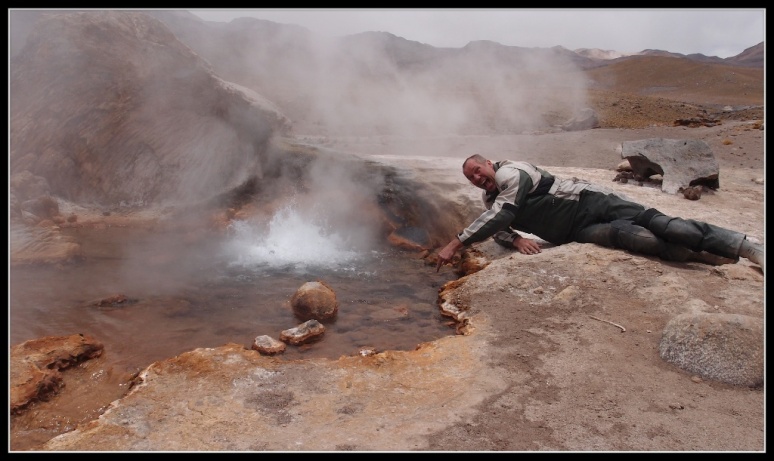 I check the water temperature to make sure nothing is fake around here and can confirm this is a true geyser. My finger will get better in a few days.
I check the water temperature to make sure nothing is fake around here and can confirm this is a true geyser. My finger will get better in a few days.  85 *C hot water bubbles out of the ground. Geyser.
85 *C hot water bubbles out of the ground. Geyser.
 This one is feeding a huge spa pool and 20 seconds later …
This one is feeding a huge spa pool and 20 seconds later …
 … I’m in. Ah spa, I missed you so much. There’s cooler spots and hot spots in the pool and one that’s just perfect. That’s where I’ll be for the next 30 minutes.
… I’m in. Ah spa, I missed you so much. There’s cooler spots and hot spots in the pool and one that’s just perfect. That’s where I’ll be for the next 30 minutes.
On my way back to San Pedro I take a different route and come across a flamingo pond …
… and a grassy oasis, enough food for some llamas.
This was a fun day, the bike handles so much easier without the luggage. Tomorrow I’ll do a round trip through the local salt desert and a remote dirt road, ca. 400 km.
Here’s some pictures of the many faces of the Atacama Desert:
By now I have enjoyed the desert enough and look forward to making my way towards Santiago. Riding the highway it’s going to be a 2 day trip.
Bolivia, Death Road and Salt Flat
‘The worlds most dangerous road’ is a gravel road through steep mountains climbing from 1200 m to ca. 4000 m over a length of 65 km. At the time when this was the only road connecting La Paz with the low lands, there were actually 200 deaths per year on average. Seeing the steep mountains the road is carved into and taking into account the total anarchical driving style of bolivians plus the absolute absence of vehicle maintanance I am actually surprised by the low number. Now the same road is a tourist attraction, many ‘adventure companies’ offer mountain bike tours downhill. I ride it the other way so I can stay on the throttle going uphill versus staying on the brakes going down. The scenery is magical, the ride a pure joy from the heat of the jungle to the cold of the cloud that covers the mountain top.
Villagers at the bottom of the ‘Death Road’.
‘Death Road’ carved into the mountain. It’s a steep edge.
Native bush at the bottom of the road.
A little waterfall along the road.
The edge.
One of the memorial places along the road.
On my way back to La Paz I come across a narcotic station, a place in the highway where every vehicle needs to stop and gets checked by narcotic officers for cocaine. Bolivia I hear is a big coca grower and the coca leaves find a lot of traditional medicinal use. Most food places and cafes offer coca tea and I drink a few cups every day to help me with the high altitude problems, headache and low energy. One interesting point about the plant I find is that when the catholics came to south america and raped the indigenous culture, they forbid every drug use including coca so they can pressure Jesus onto the good people of south america, except for those indigenous workers that worked in the gold and silver mines for the church, they were supplied with coca leaves by the church. Coca suppresses hunger and gives more energy for working hard. The interested reader probably has picked up by now that I’m no big fan of the catholic church, or any other for that matter.
Time to leave La Paz and head towards the border with Chile but not before I get a chance to ride the worlds largest salt flat, the Salar de Uyuni. Uyuni is ca 500 km south of La Paz, half of that is sealed and the other half is dirt road. A nice mix for us two, miss Enduro and me.
Desert, the main ingredient in the scenery from La Paz to Uyuni. I love it.
More of it, yes. At this point I’d say I can’t get enough of it but in a few days I will change my mind.
I get to Uyuni in the afternoon, find a cheap hostal and, more important, a petrol station that actually sells petrol to foreigners. Yes, Bolivians need to show either their bolivian ID or their bolivian number plate to get fuel and the amount of fuel gets registered with the ID in a sophisticated computer system. If one does not have either, one needs to find an international petrol station. There are a few in Bolivia but not too many. The difference is that the service personal gets accompanied by a police officer while fueling up a foreigners vehicle and also gets observed by the same officer while he multiplies the cost of the fuel times three on his calculator as a special treat for us.
Tomorrow I get a map of the Salar, pack and want to cross it from east to center and then south. I meet guides who keep telling me its easy to cross it, just punch in your position they say, into your GPS. That’s when I should’ve become suspicious, when not one guide asks ‘if’ I had a GPS but assumed I had one. I don’t. I ride into the Salar, there’s salt works on its edge and then everything gets white and the hills become distant.
The salt flats.
Having a little brake, the flats surface is quite rough actually.
After ca 60 km into the Salar I wonder if I drive in the right direction. There’s a track and I think it is the main one but am not sure. The compass shows the right direction too, I look at the surrounding hills but can’t quite make out where I need to go. I keep riding westwards and after another 10 km there is a little water on the salt. I keep riding, the 10 mm of water make the surface look like a mirror, quite beautiful. Then the water gets slowly deeper, 20 mm, 30 mm and I need to slow down to keep the front wheel in safe contact with the ground. I’m down to 20 km/h, still another 100 km to go. Not good. A guide drives past and stops, he tells me the water is only getting deeper further south. I decide to abandon my plan of crossing the Salar and turn around and call it day.
Water on the Salt Flats.
Back at the entrance to the Salar, A guest house built out of salt bricks.
Floor, table and seats made of salt.
The shop inside the ‘Salt House’.
Parked at the ‘Salt House’.
The bike was covered in a salt crust after the ride into the Salar. There was a pressure cleaning service in the village, the guys did a good job.
The next day I’m off to Chile. More desert to ride through.
The road is well maintained and great fun to ride.
A vulcano at a distance.
Llamas watching a motorcycle rider driving past.
I must have missed the bolivian border control, when I stopped there was already the chilean one. I should’ve checked the bike out at the bolivian side first but it was no problem to just check in at the chilean side. Fast, friendly, correct, just like a good german likes it. Chile will surprise me with it’s road signs that actually mean something, its civilized road users and friendly people. More about that next time. Ciao.
At Lake Titicaca
It’s been a while, I know, and now I find time to update my blog. Thanks for your patience. I’m in Puna, the nice city on the edge of lake Titicaca. The tires have arrived and it takes me all morning on this friday, maybe that is the problem that it is friday, to find a tire changing place that actually wants to change my tires. I’ve got the wheels off and a taxi takes me to at least a dozend shops but no one wants to do it. I don’t get it. At a motorcycle shop a mechanic offers to help and he comes along in the taxi to talk to tire shop owners. He can’t do it himself, imagine that. Anyway, he finds a mate who’s gonna do it and I’m glad I’m there cause he has not much of an idea what needs to happen. His two long screwdrivers come in handy though. I know, I should’ve done it myself straight away, next time. I’m glad we got it done in the end, the best part of friday is gone. Tomorrow I go on a boat tour to visit the floating islands.
Lake Titicaca lies at 3800 m above sea level.
A floating island made of reeds. People still live there, more from tourism these days than from fishing.
Colorful clothing is the trademark of traditional peruvians
Inside a hut on the island.
Some of us are crossing over to another reed island in a traditional reed boat. I enjoyed the boat ride a lot.
Then we’re off with the ‘speed boat’ to a real island, Taquile, whose people talk very quiet, even the kids are very quiet here. I like that, it underlines the tranquility of the place.
Taquile island, here meat and fish is only served for us tourists, the inhabitants are pure vegetarians.
Halim, a very nice guy I met on the boat and shall meet more times on my travels. He’s traveling the whole american continent for 18 months and has a talent to tell stories in a very catching way. I enjoyed listening to you a lot, thank you Halim.
There’s more to see in Puna but I’m just not into churches and ruins, did I mention that before? So off to Bolivia it is. Only a 2 hours ride away is the border, my first border crossing on the bike and it was way easier than I expected. Both sides were helpful, fast and effective and no costs involved.
The Bolivian customs officer checking and writing out the papers for the bike. Easy.
‘Copacabana’ on the bolivian side of lake Titicaca. Some time ago a bunch of brazilian beach ball playing bikini girls came here, stole the name and secretly smuggled it out of the country to use it at one of their beaches at home. They never got caught.
Setting over to mainland Bolivia.
On the ferry, and yes you’re right, my mohawk needs a trim.
I arrive in La Paz that evening, the worlds highest capital and bump into Halim just walking in the street. We have diner together and he tells me he’s gonna mountain bike the worlds most dangerous road tomorrow. ‘Ah’ I think, ‘challenge accepted’, I’ll do it on my motorcycle though.
Cusco to Puno
I pick up my bike, the guys heat bent the handlebar back into shape since there’s no oversized tube bars available in Peru. They did a great job. Same on the pannier, they glassed the outside and inside, painted it and made new fittings. They also bent the light tower back into shape with the help of a big steel bar and extension tube. Thank you Jorge. Tomorrow I’ll take her for a test tour through the ‘Sacred Valley’, but today Cusco presents a colourful event in its streets.
I bought a ‘Tourist Billetto’ that allows access to the Inka sites along the Sacred Valley as well as the museums in Cusco. I check out the museum of contemporary art. The exhibition shows paintings that are a bit too political for my taste, I like more inspiring modern art, art that talks to the soul. I talk to a tour organizer regarding Machu Pichu and get a quote for US $ 200.- for a days visit. $ 160 of that is transport, a 2 hour train ride plus half an hour bus ride. This goes a bit against my sense of fair charging and I decide to not support this rip off, also I’m not too keen on ruins in general.
Off to ride the Sacred Valley now. No luggage makes such a big difference to the bike. I take it easy, nice and cruisy through the turns and I look for sand on the surface now more than before. Somehow she doesn’t feel 100% safe, I stop and check tire pressure and its 30% over normal in both of the tires. Must be the height above sea level I’m at now that increases the pressure. I take the pressure back to normal and she’s all good again. This makes me think that the too high tire pressure was also part cause of the crash. A correct tire pressure would have had a better grip, definetely.
I stop at ‘Sacsayhuaman”, A big Inca site close to Cusco and take a guided tour.
The Inkas moved and fitted those huge stones with poles and rollers. Quite impressive.
Cusco from above
After 150 km round trip I get back to Cusco, pack and get everything ready to leave early tomorrow morning.
I take the main road south-east towards Arequipa. The clutch starts to get a bit loose, I pump the lever and it gets better. I can shift ok without the clutch and have to pump it a lot when I shift from neutral into first. In Sicuani I refuell and check the clutch hydraulic oil. It looks dirty, I get some new one and change it. All good again. Here I turn off the main road to head south towards Chivey, the Colca canyon and viewing place for condors in flight. The sealed road turns into gravel road after a little while and I just hope it stays dry since I’m still on my road tires, the dual sport tires wait in Puno, 2 more days. We’re climbing up and the scenery becomes breath taking again. Huge spaces and snow capped mountains.
A rain cloud ahead
Llamas fenced in
Than it starts raining heavily and I stop early in a tiny village, have a soup and go to bed. The restaurant was flooded with the heavy rain and they were sweeping the water out. The next morning is sunny and warm and I leave early to get to the condors.
Hostal and restaurant in Sibayo
A deep and beautiful canyon on the way to the canyon colca
Entrance to the Colca canyon
The condor viewing point in the Colca canyon. The opposite face is massive, the photo doesn’t do it justice.
At the condor viewing platform, looking down into the canyon
After waiting for an hour and seeing 3 condors cruising and finally landing far down in the canyon I walk back to the bike. I turn around one more time and see three big condors gliding gracefully above the edge right where I was standing only minutes ago. Patience is not one of my strong virtues, I know. I run back, take some shots from a distance and watch them gliding along the edge of the canyon, forwards and back. They don’t need a single flap of their wings but use the uplifting air current instead to gain height. Only the tail moves a bit to steer the huge bird. A majestic and gracefull movement it is, ‘The Flight of the Condors’.
I leave the canyon and make my way towards Puno at lake Titicaca, ca 400 km to go. The road is good and only the occasional rain slows me down. After 200 km, riding the high planes of the Andes I come across a little lake with big, unusual birds on it. I stop, yes it’s flamingos. I slowly walk down to the waters edge but the birds see me coming and take off, move a little further away.
Flamingos on a high country lake
When I get close to Juliaca, the rain turns into peanut sized hail with lightning and thunder. I stop for a little while and wait it out under a roof.
The road is covered in an inch of hail, passing trucks create a track I follow in slowly and after 3 km the road is clear again. I come through Juliaca, a big City but easily the dirtiest one I’ve ever been to. A friend told me ‘don’t stop in Juliaca at all, get out quick’ and now I can see why. Huge holes in the middle of the highway, dirt everywhere, Juliaca is the criminal capital of Peru. Being so close to Bolivia it lives of black markets and smuggling. I pass through it and reach Puno at the edge of Lake Titicaca, get a ricksha to guide me to the hostel I made a reservation at, have a hot shower and fall to bed. Good night Puno, tomorrow I’ll get the tires changed and a chance to explore Puno on foot. Chao.
Lima to Cusco
I leave Lima late in the morning and follow the ‘Panamericana’ south. Typical highway riding through desert, a bit boring but I get south pretty fast. At Nasca I leave the highway to follow a beautiful mountain road until I run out of daylight.
Switchbacks take us up from sea level to 3000 m.
The winding road continues on the high plateau.
Day two follows yesterdays afternoon, winding alpine roads, turn after turn, this is motorcycle heaven. The road is smooth, dry, clean and has a beautiful flow to it. I’m thoroughly enjoying the ride.
This guy in his truck was a tad too fast through this curve but it looked like no one got hurt.
It’s midday and we ride up another mountain pass. I’m letting her of the leash a bit more and everything becomes one, the mountain-the road-the bike-me-the ride, I’m in ‘The Zone’. At the bottom of the mountain the curves open up wide, I take her off the throttle a bit, the fun part is over and fun it was. Yess! Suddenly, at the end of the long, wide curve, the front wheel just slides out from under me, then the rear. We are going down at 100 km/h and just slide along the straight road, bike first me second, until we both come to still stand. Everything happens in slow motion. I get up, am perfectly fine except for a scratch on the hip from the impact.
Right after the crash.
I can’t believe what just happened, walk back to the curve and notice some sand around the centre line, can clearly see where the front lost grip and then the rear.
A couple of men help me get the bike back up. She’s a little more hurt than me but nothing major. Bent handlebars and light mount, windscreen came off and one indicator broke plus the left carbon/kevlar pannier has a crack.
Lucky us, thank you angels. The bike still rides ok so I decide to finish the trip to Cusco and ride the remaining 120 km. I visit the next hospital to get the scratch cleaned and am surprised at the size, cleanlyness and professional service of this place in the middle of nowhere. There’s even a heli pad. The nurse at the reception is suisse, one of the many doctors is german and he asks me for a ride down to the village once i’m finished. They check me for all sorts of injuries, clean end cover the scratch and charge me a total of $10, inclusive medication. Wow, what a fantastic service. The doc hops of in the village and I make it to the Cusco hostel I booked online. I take the bike to a mechanic, the shredded pants to a leather worker and decide to stay a few days here and recover. Cusco is beautiful, it reminds me a bit of Salzburg and I notice I enjoy being amongst tourists. That’s definitely a first.
Placa de armas in Cusco.
Upstairs restaurant with a view
The Massive Jesus statue, a gift, overlooking Cusco. Talking about ‘Big Brother’.
Contrast of modern times, old stone built church and new plastic coca cola christmas tree.
Me at the famous stone wall of Cusco.
A couple of ladies with child and baby llama.
The beautiful walk ways of La Bas in Cusco.
Colorful traditional woman’s clothing, still many woman wear it or carry their babies in it.
‘The march of the katholics’
Entrance to the market.
Tomorrow I’ll pick up the bike and visit the sacred valley. I’m still undecided wether to visit Machu Pichu or not. I’m not so much into ruins but am curious if there’s some energy I can pick up similar to Aires Rock in Australia that I experienced last year, (www.helmutgottschalk.wordpress.com). Ciao for now.
Getting out of Cajamarca
Cajamarca people use the strike to meet in the ‘placa de armas’ and have fun.
Two woman with their traditional hats
The church uses the strike to go member fishing.
A dressed up llama
Me supporting the local economy
After 3 days here I get the feeling I’ve seen it all and I want to get out. The swelling in my foot got less and painkillers plus anti-inflamatories give me enough confidence to ride again. I pack and leave early morning on day 4 of being stranded here. I go south on a good sealed road and drive through some half opened barricades, no one there. Yes, moving again. Ca. 40 km south there’s a village and those guys still have their barricade up. I negotiate and finally pay with a photo taken of one of the guys sitting on the bike.
Easy bribe: a picture of one of the barricaderos
Thanks for letting me pass guys!
Over the next 80 km this stopping, negotiating and letting get through goes on for 6 more times but they really have nothing against tourists, quite the opposite. There’s always one who heads the barricade, usually a man, and he steps up and talks to me and it always changes from ‘no passa’ to ‘bien viaje’ in a few minutes. They want to know about the bike, where I come from and where I’m going. Boys talk helps.
Another barricade.
Then, 120 km south of Cajamarca is another one. A tiny village. Spiky branches across the road plus barbed wire 1 meter above the ground. There’s 2 cars waiting to get through, 2 families with kids.
No go after 120 km.
The woman comes up to me: ‘No passa!’ I take off my helmet and ask if passa is ok for tourista. She: ‘No Passa!’ and walks away. I wait for an hour and then decide to ride back to Cajamarca, there was just no getting past her. Damn! Same procedure on the way back, barricades, negotiate again, passa. Finally I’m back at the hotel, Groundhog Day all over again.
The next morning there’s good news, roads and petrol stations are open. I leave early.
Leaving again.
I fuel up and take the main road west. Don’t even make it out of town. A solid double barricade, no go. I get really frustrated, wave down the cops and ask them to get me the … out of here. They know a small dirt road but when they get to the barricade there they’re not getting through. they turn around and wish me luck. I line up the one guy who stands in the hole in the barricade and yell: ‘Tourista’ and he lets me pass without a question. 20 more km until the dirt road joins the highway and I’m free. Yess!
I’m starving, stop for breakfast at this boys stall and get some bananas:
He insists in showing me his pig across the road:
Two hours to get to the coast and there’s no more signs of a strike. South from here on the ‘Panamericana’. A highway through the desert, boring. I get to Lima the next day, pack my camping gear that I’ve left at the hostel and arrange for a courier to ship my spare tires to Puno, lake Titicaca. Actually the hostel arranges for the shipping, they are so helpful and supportive of me, thank you Veronica and Patty and the rest of the friendly staff at ‘The Place’ in Miramar. The next morning I leave for Cusco, a two day trip that’s going to be fun and pain for both of us.
Getting to Cajamarca
7 am, a winding, sealed road takes me slowly into higher regions, after 60km there’s the turnoff to Cajamarca, still 350 km away and that’s 350 km of dirt road from here onwards. I was not expecting that. It’s a rough road, lots of potholes but not much traffic. I had no idea this is going to be a dirt road, not that I mind or have another choice. Lucky it’s a dry day so the road tires will work ok. They hold fine in braking and accelerating, only when I lean the bike a bit the front wheel starts to slide. Knobbies would definitely be better. We go up a pass, it gets cold. Coming down the vegetation changes from rocks to this:
Nice and warm again down in the valley. I come to a bridge over a big river, a little village is right there and I wonder if I should look for fuel. I don’t and carry on. Another pass, uphill for an hour and a half, a few houses spread along the way, cold again and stunning scenery. Up here at the top lives nobody, up here in the clouds I enjoy the stunning scenery the Andes offer.
The climb begins, the last village on the way.
In the clouds of the Andes
The pass road
It’s lunch time, the downhill goes all good and then just before the village of Celendin where I need to fuel up is a road block. Big rocks all across the road, a peruvian flag waving in the wind and a bunch of guys yelling at me: ‘No passa’. I stop, take off my helmet and just sit there on the bike and have no clue what’s going on here. Two guys start a loud discussion and one of them goes and moves some rocks to let me through. Thanks man, I ride through, into the village to the gas station only to find it cordoned off, ‘ No gasolin, no servicio’ the woman explains. All my begging and attempts to bribe fail.
‘No gasolin, no servicio!’
Waiting for fuel to no avail
A cop hints that there’s another petrol station, and there they fill up the bike’s tanks, thank god. I still haven’t grasped the full size of this strike, I think it’s only local. I leave the village there’s another barricade on the way out but this time I won’t stop, I just ride over the concrete power pole. Another little village and another road block right in the middle of the plaza. This guy just won’t let me through so I find a detour road. It’s raining, the dirt road is on an sideways angle, very slippery, the bike starts to slide sideways, both wheels simultaniousely, I loose control, fall with the bike to the left and feel my left foot getting trapped and overly stretched by the pannier. Everything happens in slow motion, I listen for sounds of bones braking or tendons snapping while sliding along but there is only silence, thank god. I pull myself out from under the bike and a group of woman come running and yelling. They make sure I’m ok and help me lift up the bike. ‘Muchos gracias senioras’. I hop on the bike and carefully ride the 100 meters of slippery road before it joins the sealed road to Cajamarca. Its getting late when I come closer to Cajamarca and the road blocks get bigger. No way to just ride through, also I can’t use my left foot anymore, I need to negotiate 4 more road blocks before I get to the centre of Cajamarca and find a hotel. I get bandages, arnica and anti inflamatories from the pharmacy, tend to my injury, pop a couple of painkillers and homeopathic arnica and fall asleep in the hope that the massive swelling will go back over night. This morning I wake up to a still swelled foot but with less pain and I’m able to walk, thank god. There’s a huge demonstration going on and after checking the news online I realize that Cajamarca is the centre of a massive anti minig demonstration.
Anti mining demonstrations in Cajamarca keep me stranded there.
The latest strike info gets put up here.
Many thousand people gather at the ‘Plaza del armas’ to show their solidarity on this issue.
Food seller
Guys watching the demonstration
Even dressed up llamas join in.
The demonstrators shut down the airport, there’s no traffic into or out of the city, police everywhere on foot, military cruising around in trucks and thousands of people in the street carrying banners: ‘Agua si, oro no!’ yes to water, no to gold. 2 ministers already quit over this issue and the president is between a rock and a hard place since mining is the big money maker for Peru and this is going to be the biggest mining project for Peru.
Anyway, tomorrow morning I pack and see if I can leave the city. Wish me luck!
Leaving Tarapoto
I leave Tarapoto early that saturday morning. All three tanks are full with 95 gas, chain is oiled and a beautiful day lies ahead. I take the same route back to Lima that I came here but after 50 km a road worker stops me to let me know that there has been a slip, it’s blocking the road, two people have died and it will take at least two days to clear it. Bummer. I turn around and take the ‘long way home’ to Lima, north-west on sealed roads, winding mountain passes, a beautiful ride. There were many stops and waits caused by roadworks, here’s one:
Those guys wanted to know everything about the bike and my travels.
After going up and up following the winding pass road the descent began and only after a little while riding downhill all of a sudden the engine cuts out. I stop on the side of the road right at the beginning of some road works. I start her and she starts fine but the moment I put her in gear she dies. I take the bike apart so I can access the wires to the side stand safety switch that I suspect to be faulty. I measure current and can’t find anything wrong. I put her back together. One of the road workers suggests to just let her roll downhill from here until i get to Pedro Ruiz. I do and enjoy the roll for the next half hour and roll straight to the hotel ‘Casablanca’.
Rolling downhill
Rolling downhill
I’m a bit frustrated cause I can’t figure out what’s wrong with her. Next morning I go to the internet cafe and ask the KTM forum on advrider.com for help. Instantly I get suggestions, one in particular sounds helpful: ‘Ground the green wire from the gear selector sensor to chassis, that should eliminate all safety switch functions.’ I go back to the hotel car park where my bike lies in pieces and apply the suggestion. After putting her back together I start her up, pull the clutch, drop her into first gear and she stays alive. Yess! Clean up, packing, and after another night in Pedro Ruiz I leave early next morning. South from here towards Cajamarca.
Buy buy Pedro Ruiz.
Full Blast
Reenacted in daylight: Me drinking ayahuasca in the ceremonial hut
Here I sit again in the ceremonial hut in complete darkness and drink the ayahuasca, this time the cup is filled to the rim. I sit back like everyone else and wait with my eyes closed. A massive wave rolls over me, I’m totally overwhelmed and focus on my breath to keep a last straw to this reality. I breathe in and out slowly and consciously through my 3rd eye. Colours appear in subtle thin luminescent lines describing an ever changing geometry. I manage to keep my focus on the breath going in and out through the 3rd eye and all of a sudden I become a small ball of pure consciousness right outside my forehead. I begin to travel through luminescent landscapes, another dimension, and navigate with my will. This is incredible. I sense other beings in this landscape but can’t see any. Then a cross between a T-Rex and a robot comes at me and gives me a hug. I feel I could chase him away if I wanted to but am curious what he has to offer. Just a hug, that’s it. Then I realize I can move between the state of pure consciousness and the state of thought. I find the state of thought tiring and useless unless I need to do something where thought is needed, otherwise the state of consciousness is much nicer, perfect peace, calmness. I still can change between the two states by pure will but want to find out how I can do that in a ‘normal’ state of being. No solution comes up. Then the colors and landscapes fade away and I’m back to ‘normal’. Thoughts running amok and an occasional picture appearing on my mind. One is of a newborn baby with painted fingernails. I take it as a vision that my son’s Phil and his partner Vanessa’s baby that’s due every moment now will be a girl. Carlos starts singing the icaros and calls me to him to sit in front of him. He gets up and performs a spiritual cleansing ceremony on me. He blows tobacco smoke on my head, sings icaros, works the rattle to get rid of evil spirits and finally sprays agua flores over me. He hands me his cigar and says: ‘Smoke, important to smoke now.’ So I do with pleasure. I lay back down and get a chance to look at me and my life from a distance. I learn a lot about me that night. After ca. 5 hours I fall asleep.
Carlos washes the mokura roots
Me drinking mokura
I will fast now for 8 days and will do 4 more ceremonies with ayahuasca plus mokura, a focus enhancing plant, but this will remain the one ceremony that has the biggest impact on me. I want to learn to switch to a state of pure consciousness in a ‘normal’ state of being. The search goes on …
Ayahuasca Ceremony
I was curious about ayahuasca, the tea the shamans of the amazon jungle use to heal, see future events, soul journey and have out of body experiences. A man I met a few years ago and who runs a psychiatric clinic told me:’ I’ve meditated for over 30years, but I had more insights about me and experienced more liberation of the mind in one ayahuasca session than in 30 years of meditating.’ He now travels to Brazil twice a year to participate in the ceremony. My curiosity was ignited.
The ceremony hut with the purging buckets outside
Here I am now in the peruvian amazon hopping on a ricksha to catch a ride with Carlos Chavez, a 32 year young shaman who’s grandfather taught him everything he knew about ayahuasca.The 20 minute ride takes us from Tarapoto to Carlos’s ‘healing centre’ in the jungle. Nothing romantic about the location, a very basic round, open hut serves as the ceremonial place. There is 6 of us, a couple from Argentina, Carlos, his apprentice Juan and Ulele, a local. We make ourselfes comfortable on our matresses, Carlos lights a candle and we sit still for a while. Once its absolutely dark outside Carlos puts on his shaman robe and feathers, lights a black tobacco cigar to keep bad spirits out and sings a little to the bottle with the magic drink.
The head feathers, agua flores, ayahuasca
Then everyone gets a cup full or half a cup for us first timers. The red-brown thick and slightly warm liquid tastes like mud and rotten wood. I manage to keep it down. Then we sit back and wait in total darkness. After 30 min I can feel a little tingling in my lips and cheaks. This tingling grows into my whole body but does not increase in intensity. Some blurry black and white pictures appear in my mind but I can’t make anything of it and then it’s all over. Only my thoughts keep racing around quite a bit, not a nice feeling either.
Shaman and Ayahuascero Carlos Chavez
Then Carlos begins to sing a song, a peruvian shamanic icaro. It starts with a quiet whisper, a very light whistle and then words. I find it very beautiful. This goes on for a while and 2 guys start throwing up heavily. Something is working hard in my guts and I go outside to see the ‘banyo’.
The banyo
All that was not up to what I expected and I decide to do it again and just drink more. When Carlos takes me back to the hotel the next morning he offers me a 8 day fast with 5 ceremonies and promisses that it will be much stronger. ‘I’ll let you know tomorrow’ I said and after a good night sleep I decide to do the 8 day ‘diet’ since I don’t believe I had the full experience yet.
It’s going to be amazing!
Lima to Tarapoto
Its time to leave Lima and head for Tarapoto, 2 days north and on the other side of the Andes, right in the peruvian Amazon.
This shall be a day of extreme changes. Bye bye smog and jammed, packed traffic and welcome blue skies and winding road. And winding it does, up and up just like the roads in the european Alpes. Only here the road keeps going up and up for three hours. It’s getting colder, I stop when I see snow capped peaks, ca 4300 m above sea level, and put on warm clothes.
Llamas on the road at 4300m
The air is definitely thinner up here, I feel a little dizzy and tired, there’s also a headache coming on. I consider taking soroche pills against altitude sickness but decide to ride it out and see what happens. I keep breathing deeply and hold the inbreath longer to squeeze more oxygen out of that thin air. The climb goes on for a little longer, the engine looses a bit of pull. The pass is at 4800 m, after that we descend to a high plateau that I will ride for a few hours. I should have taken those soroche pills. Headache, dizziness, and a negative mind persist. I’m aware I’m on the first day of the ‘trip of my life’ and not enjoying it, the lack of oxygen brings on a little depression. All this is completely gone by tomorrow. Now we’re riding downhill for hours, rocks change into bush and later lush trees, villages apear. I stop and stay the night in a hostel in Tingo Maria. A jungle town, warm and humid, I get a first impression of the Amazon. I’m tired and a look in the mirror shows blood shot red eyes, altitude sickness took its toll. I fall into bed.
Safe parking for the bike here in Tingo Maria.
Today I wake up feeling great, I slept like a rock. Breakfast, packing and off we are. When I say we, I mean the bike and I of course. I should find a name for her! Suggestions! she’s very tall, dark, fast, fun, reliable, fun, did I mention fast? and fun?
The road is fantastic, winding with a nice flow, immaculate smooth surface, like a race track. I’m glad I left the road tires on. I brought dual sport tires, a Heidenau K60 Scout rear and a Metzeler Karoo 2 front. I want to get a bit more out of those road tires before I switch. The temperature rises from mid 20s to low 30s. I’m sweating and drinking lots of water. Thanks camelback.
I come through a village, nice and cruisy, then this person steps into the road in front of me and waves his arms. A cop. I pull over. He points to my helmet, I take it off. Me: ‘No habla espaniol.” He pulls out his wallet, grabs a bil and waves it at me. Me: ‘NO!’ I put my helmet back on, start the engine and drive away. Gone in 60 seconds. I mean come on, at least he could’ve told me that I did something wrong. That was just too blunt, sorry mate.
But there are other cops and military too. 30 minutes later I come to a military check point.
The first guy waves me through, I roll on, the second guy waves me over to the side. I stop. He and two mates come over, smile, shake my hand, ask for the documents, where I’m from, how much power has the bike, … . My answers are the juice for their story tonight at the bar. There is two kinds of cops: the real ones that check documents and the pricks that want money. The second kind I don’t take serious and they sense that and leave me alone.
On one of the many bridges between Tingo Maria and Tarapoto
Then the sealed road ends and a rough dirt road cuts from now on into the amazon jungle. Its a hard piste with rocks and big rocks sticking out. With lots of potholes, deep but not too big. This is not comfortable riding. But fun. This is where this bike shines and the faster we go the smoother the ride gets. At 90 km/h I hardly feel the potholes, and at 120 km/h she’s right at home. I brake hard and throtte hard to find the point where the tires loose traction. I’m positively surprised how well they hold on firm, dry dirt considering they are road tires.

 Road tires on dirt hold surprisingly well, the bikes weight helps them to grip better.
Road tires on dirt hold surprisingly well, the bikes weight helps them to grip better.
New bridges guide the piste across rivers, always a point to slow down. After yet another bridge is a group of 3 teenagers, dressed the same but no police or military uniform. Everyone of them has a shotgun slung over his shoulder. I stop, helmet stays on and engine stays running too. He opens his hand to show me a coin, I: ’No!’ and drive away. I don’t know what to make of this. There’s too much traffic for them to be thieves, but no uniform and shotguns make them nothing official.
I come to a bridge that’s closed to traffic. The whole lane broke and sacked down by 2 meters in one spot. A barge takes us across the river.
The barges are big enough to even carry a full size truck.
After a few hours the road changes again to a sealed surface. Two more hours and I arrive in Tarapoto, check in at a hostel, shower, eat and fall into bed.
Tomorrow I meet Carlos Chavez, a local shaman, to discuss my participating in an Ayahusca ceremony.
Hola Lima, nice to meet you
My bike has arrived at Lima airport 2 days before me, thank God, and Mainfreight freighters from Christchurch/ New Zealand. I stay at ‘The Place’, a nice, clean hostel with wireless and very friendly and helpful staff. Miraflores, the part of Lima the hostel is in is clean, safe and touristy with fashion shops all over the place at the waterfront center ‘Larcomar’. A high contrast to the rest of the city of Lima. I’ll be attending a spanish class for a week, this leaves enough time to clear the bike from customs. Gustavo, an ex customs worker and a helping hand to the hostel offers to help clear the bike and it turns out he’s heavens sent. For a small fee he negotiates with customs, the storage warehouse and the airfreight company, takes me to and from the airport and helps me in the end to unpack the bike. Thank you Gustavo. It takes me 2 hours to put the bike back together, we push it out of the safety of the warehouse onto the road and Gustavo gets some fuel. There are a few bystanders watching me tightening the luggage, then I hop on, turn the key, wait the 3 seconds for the computer to check systems, I press the start button and, … nothing happens. Nothing, not even a little try to turn the engine. The battery is full, headlight is working fine. I turn the key again, same thing. Computer shows 5, 6 different failure codes and I just think ‘F!@#k! serious problem, don’t have a clue, need KTM diagnostic computer, need tow truck, … F!@#k! Then a bystander comes up and points at something right in the middle between engine and tank, I hop off and see a loose plug right in there, I connect it, turn the key, push the start button and she turns over and purrs like she should. I feel blessed by so much help, I don’t think I would have spotted that loose plug in there, my mind was already organizing a tow truck. Turns out the guy stopped and parked his motorcycle on the highway to come over and check out my bike. Thank you, and I think that sums up my first week’s experience: Everyone I’ve met is very friendly and super helpful. What a great start to this trip.  Miraflores at night, a very safe and clean part of Lima with amazing views of the pacific.
Miraflores at night, a very safe and clean part of Lima with amazing views of the pacific.
 Security check to get ‘Out’ of the storage warehouse
Security check to get ‘Out’ of the storage warehouse
 Inside the Warehouse. Everything airfreighted into and out of Lima goes through this warehouse. Its huge and busy, I think they’re having a forklift race on right now.
Inside the Warehouse. Everything airfreighted into and out of Lima goes through this warehouse. Its huge and busy, I think they’re having a forklift race on right now.
 There she is. Reunited again, we’ve been separated for too long. And yes my Sweetheart back home, I feel the same about you, even more so.
There she is. Reunited again, we’ve been separated for too long. And yes my Sweetheart back home, I feel the same about you, even more so.
I go for a walk to explore the surrounding and take a few pictures:
 Beautifully restored buildings in an enclosed/secure area
Beautifully restored buildings in an enclosed/secure area
 Furniture restauration on the road, viva Lima!
Furniture restauration on the road, viva Lima!
 Waterfront Skate Scene, for you Nico!
Waterfront Skate Scene, for you Nico!
 A huge outdoor area with cafes and restaurants is tiled.
A huge outdoor area with cafes and restaurants is tiled.
I invite Alexandro and Carolina, two very patient spanish language teachers, for lunch on the last day. I’ve learnt as much as I could take in, but you two did share your cultural and social wisdom with me on top of being great teachers, thank you guys, I highly recommend you two from the Peruwayna school in Lima and wish for you Caroline that you find a husband soon.
Friday afternoon, time to pack. I leave tent, camp gear and tires at the hostel. I’ll be back in a couple of weeks to head south. For now I’m set to go to Tarapoto, then further into the jungle by boat to take part in an Ayahuasca ceremony with a local shaman.
-
Recent Posts
- Medellin, Colombia
- Through Venezuela to Bogota
- Boat trip up the Amazon
- Alter do Chao
- The famous Transamazonica road
- Jericoacoara, riding the beach
- Lencoise and the Chapada Diamantina National Park
- Salvador, at the wrong end of a gun.
- Heading north from Rio
- Brazil, Rio de Janeiro
- Brazil, Sao Paolo, Parati
- Brazil, Foz de Iguazu, Bonito, Pantanal
- Brazil, Florianopolis, Curitiba, Guarapuava
- Uruguay
- Buenos Aires
- Chile to Argentina
- Santiago de Chile
- The Atacama Desert
- Bolivia, Death Road and Salt Flat
- At Lake Titicaca
- Cusco to Puno
- Lima to Cusco
- Getting out of Cajamarca
- Getting to Cajamarca
- Leaving Tarapoto
- Full Blast
- Ayahuasca Ceremony
- Lima to Tarapoto
- Hola Lima, nice to meet you
Archives
- September 2012 (5)
- June 2012 (4)
- May 2012 (7)
- January 2012 (3)
- December 2011 (4)
- November 2011 (6)
Meta

